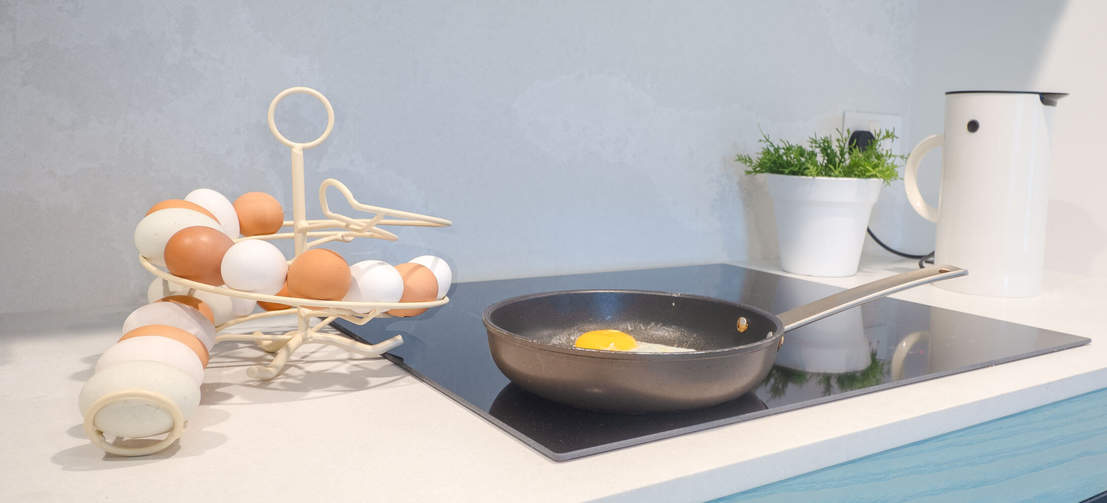
They might be small, but the humble egg is a nutritional powerhouse. Plus, their versatility means they can be used to make thousands of delicious recipes we all know and love. But do you know fact from fiction when it comes to the amazing health benefits of eggs?
Busting the biggest myths
You’re probably not unfamiliar with hearing that eating eggs can cause high cholesterol and can lead to cardiovascular problems. But, the reality of this is actually very different.
While the yolk of a medium egg contains a high level of approximately 186mg cholesterol, the majority of cholesterol is made by the liver as opposed to through diet. Approximately 25% of the cholesterol in the food we eat is absorbed by the intestine and 75% of the cholesterol in the blood is produced by the liver.*
Rather, high cholesterol can be caused by genetics and lifestyle choices like smoking and lack of exercise. This isn’t to say diet is not a contributing factor towards high cholesterol, though. Rather, a diet high in saturated fats such as fried foods, processed meat, and full-fat dairy products should be more of a cause for concern.
Eggs are also not responsible for clogged arteries or cardiovascular problems. It’s actually how you cook your eggs, or what you eat with them that could play more of a role in heart health. Frequently frying your eggs in lashings of butter or serving them alongside fried bacon every morning is more the problem. But, as with anything, moderation is key and you should always consult your doctor for tailored medical advice.
Why eggs are so great
A great source of micro and macronutrients
Whether it’s the yolk or the white, eggs are full of nutrients and vitamins that are useful for your body to function properly. Eggs contain carotenoids, antioxidants that help to fight against age-related diseases, especially eyesight.
Plus, eggs are rich in protein (2 eggs are equivalent to 100g of meat), vitamins A, D, E, K, B2 and N12, as well as phosphorus, magnesium, potassium and minerals, all of which keep your body in perfect working order.
The vitamin B present in eggs helps your brain to function properly, i.e. memory and concentration. Eggs can be consumed during pregnancy, as the nutrients present in eggs, including vitamin B9, help the growth and proper development of the fetus.
Eggs also contain Zinc for hormone regulation and with the proteins and vitamins they provide, eggs are a real ally for your hair. There are many recipes on the internet for caring for your hair with eggs but our favourite is using one egg, a few drops of sweet almond oil (no more than 4) and a spoonful of honey – your hair will thank you! Leave on for 10 minutes and rinse thoroughly.
Low calorie
Did you know that an egg contains only 90 calories? Two eggs at 90 calories each and you can make a low-calorie but very tasty omelet. The appetite-suppressant effect of eggs also makes it a food to include in your meals if you want to feel fuller for longer.
Sweet treat or protein-packed lunch?
Aside from the various health benefits, eggs can be used in many different ways, allowing us to vary our meals. Whether you like eggs fried, boiled, scrambled, in quiche, in cake or in pancakes, there’s something for everyone.
You can find a cake recipe here or why not try out a delicious banana bread? And for the perfect pancake recipe click here.
How to choose your eggs
Nothing beats the taste of freshly laid eggs from your hens. Plus, when your girls are as happy as can be in an Eglu Cube Chicken Coop, they taste even better! The love you put in towards caring for your flock really is returned with their labours of love in the form of tasty eggs. Having them on hand, without worrying about going shopping, is a real pleasure too.
You can even show off your hens’ hard work in the Omlet Egg Skelter. Not only will the beautiful design stand out in your kitchen, but it keeps your eggs neatly arranged in order of laying to ensure that you always use the oldest eggs first, meaning no waste.
But, if you’re yet to experience the joys of chicken-keeping and are purchasing your eggs from the supermarket, here’s what to look out for. Please note that the nutrient content may vary slightly depending on the origin of the eggs you consume. The omega 3 content may be lower if you buy your eggs from a cage farm instead of organic.
Omlet and your eggs
Eggs have an array of benefits, and when chicken keeping is made so easy with Omlet, why miss out on the delight of having them fresh from your garden? From our Eglu Cube Chicken Coop for super speedy cleaning, Autodoor to put your flock to bed and the Walk In Chicken Run to give your chooks space to roam, shop Omlet’s remarkable range of chicken products, designed in-house by expert chicken keeping, animal loving engineers.
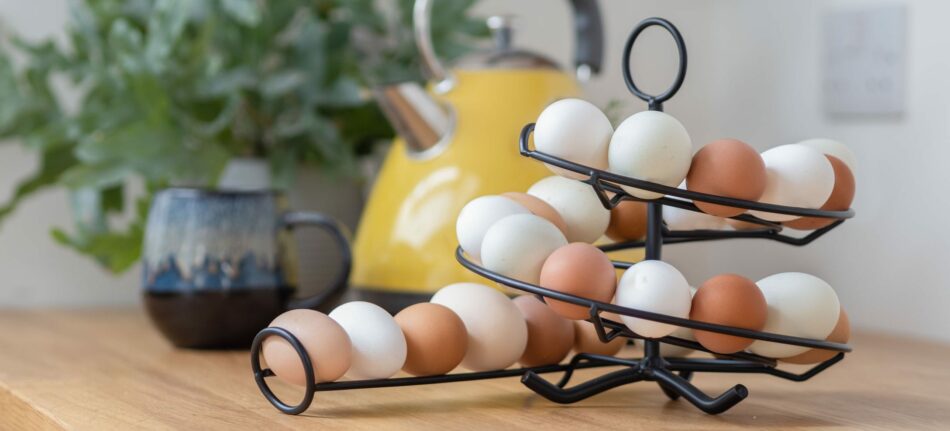
*Cholesterol Overview: LDL, HDL, Triglycerides, What Cholesterol Levels Mean (webmd.com)
This entry was posted in Chickens on April 28th, 2021 by alisa.deluca

This article is a part of our Pride of Omlet series, a collection of amazing stories which shine the spotlight on extraordinary pets and share their selflessness, bravery, talent and compassion with the world.
-Written by Anneliese Paul

Mipit is a Mental Health Assistance Dog for his human, Henley. Mipit keeps Henly alive and independent. Who wouldn’t love a dog that can put out your recycling, answer your phone, and be your best friend, come rain or shine?
Six years ago, homeless and experiencing mental health crisis, Henley was given a glimmer of hope when she was offered a flat. She reconnected with her mum and dad, and slowly, life started to improve with their help. But something was missing. Henley needed a companion.
Henley’s autistic and always wanted an autism assistance dog, but by now, Henley was too old to apply. One day, Henley and her mum went to get their hair cut. The hairdresser suggested they go to the nearby pet shop to ask if they knew of any puppies; the pet shop gave her two phone numbers. As Henley was leaving the shop, she spotted a leaflet on the window about Mental Health Assistance Dog training.
Henley rang the breeder’s numbers and soon after brought home her first puppy. A jug (Jack Russel cross Pug) she named Lottie. First, she began training with the Kennel Club good citizen dog scheme and then assistance dog training with Darwin Dogs. But at six months old, Lottie was attacked by a pack of six dogs, and Henley decided to stop her training to give her time to recover. With Lottie better, Henley felt it would be good for her to have a friend. So she called Lottie’s breeder to see if any more pups were on the way. Luckily Lottie’s grandmother was pregnant, and when the puppies were born, Henley went to visit and brought home Mipit.
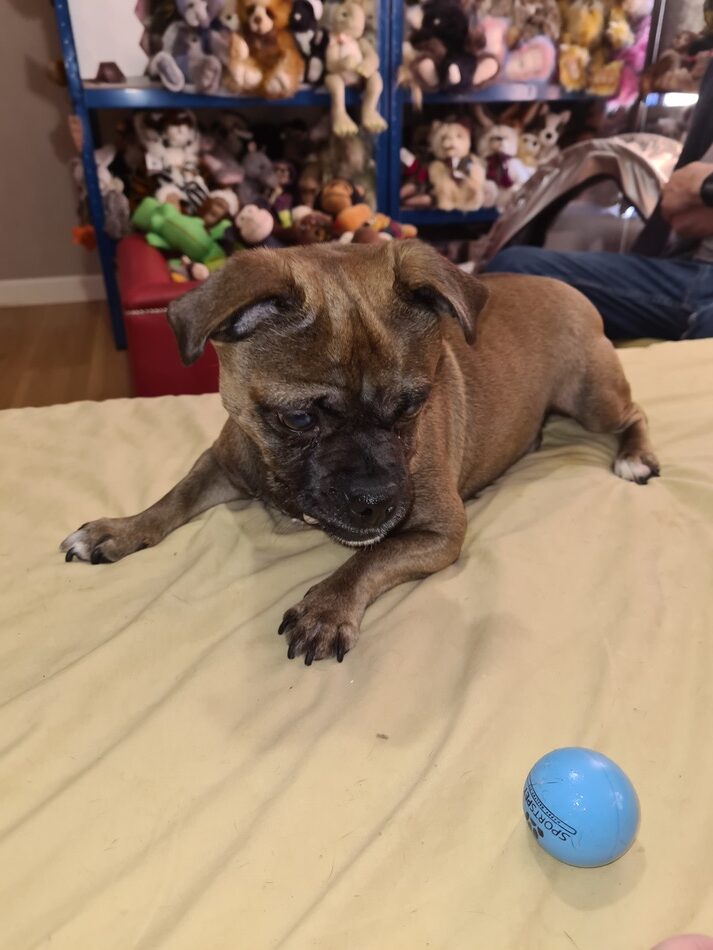
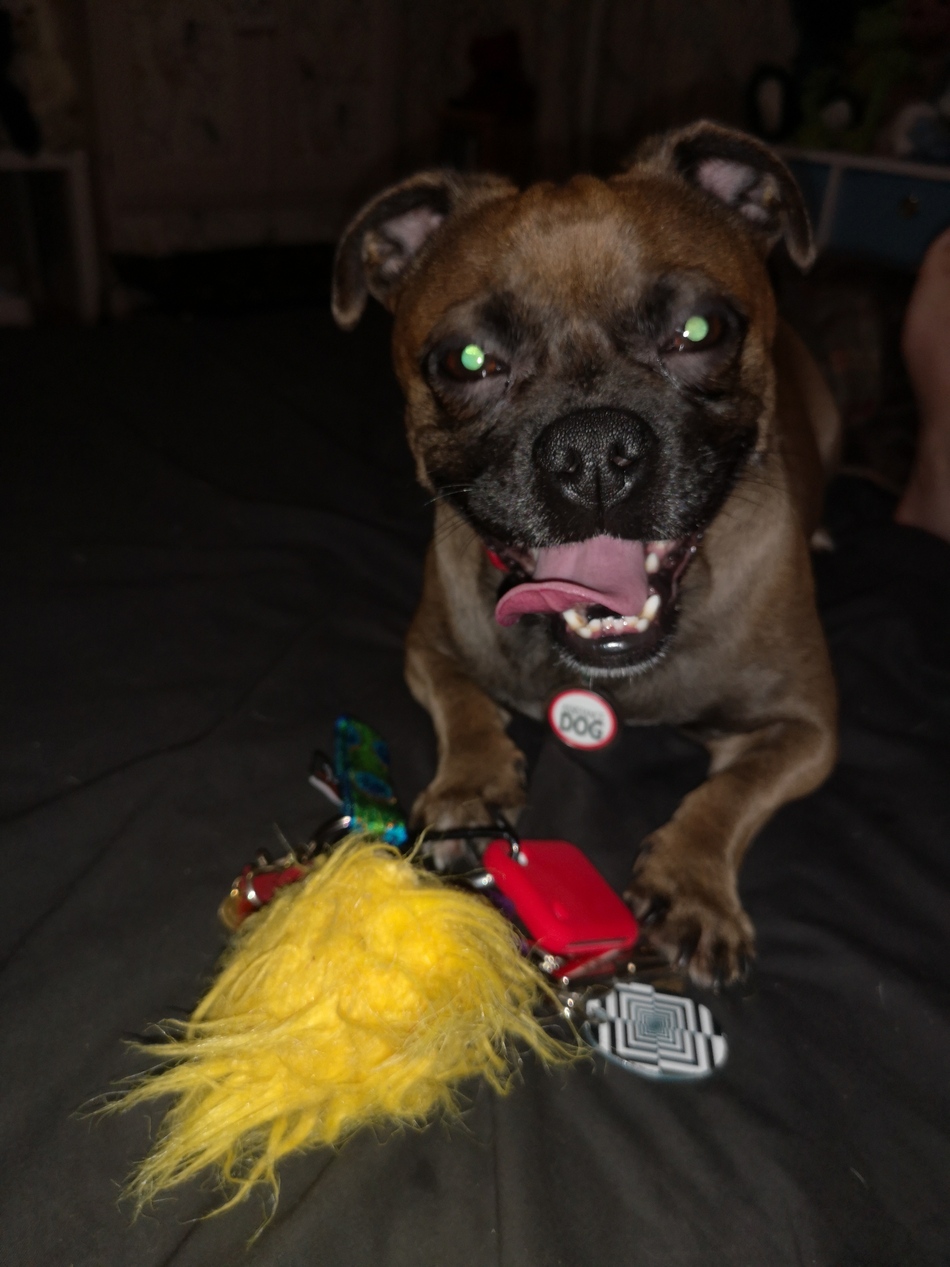 Mipit’s a Jug like Lottie, who Henley chose for his rebellious nature, but despite wayward first appearances, he’s proven to be intelligent, loving and loyal. Within a few weeks, Mipit was doing things that Lottie had taken months to learn, and Henley decided to focus her assistance dog training with Mipit.
Mipit’s a Jug like Lottie, who Henley chose for his rebellious nature, but despite wayward first appearances, he’s proven to be intelligent, loving and loyal. Within a few weeks, Mipit was doing things that Lottie had taken months to learn, and Henley decided to focus her assistance dog training with Mipit.
He flew through both bronze and silver Kennel Club assessments by the age of one. He was too young to start gold, so Henley started assistance dog training. In under two years, he’d completed all three levels. Lottie had taken the same time to complete only one. Mipit’s instinctive with training. “He can see into the future,” says Henley. “It’s like he already knows before you’ve trained him.”
Henley uses a wheelchair and Mipit is always beside her, ready to help. He opens doors, picks up the phone and takes out the recycling. He does things to make Henley laugh, like playing hide and seek under the duvet. He never turns off. Mipit’s training with Darwin Dogs is unlike any other assistance dog training. Henley has developed a partnership with him to train him in three special skills that are unique to her needs.
Mipits first special skill is to lay flat on Henley’s knee, giving deep pressure therapy to help with the pain she has in her legs. Secondly, he’ll fetch and retrieve anything up to his own body weight. His third skill is a showstopper. If Henley’s been upset anywhere, Mippit will sing to her to help her recover. He often sings Henley out of Sainsbury’s to get her ready for the journey home, and Mipit has become known for his singing in their home town. Sometimes Henley is stopped by people asking, “Are you the one with the singing dog”, and Mipit will gladly give a little performance.
Last year Henley lost her mum. This was devastating for Henley’s mental health. Both Henley and her Dad, Chris, credit Mipit with keeping them a team, working through difficult times and keeping their bond strong. “He forces us to be together in a lovely way. He’ll cuddle Dad and bring him to me. He dives up and gives me kisses when he knows I’m poorly.”
Mipits unconditional and constant devotion to putting a smile on Henley’s face gets her ready for the day, every day. With the help of Mipit and Lottie, Henley hasn’t self-harmed in six years and now lives in a bungalow with a garden with six chickens for company. Soon two rabbits will be joining their extra special support bubble.
Henley’s dad Chris says, “I watch Mipit because he picks up on Henley’s mood. When she’s not feeling good, he moves closer. It gives me comfort to know Mipit is looking after her. He’s a cracking little chap.”
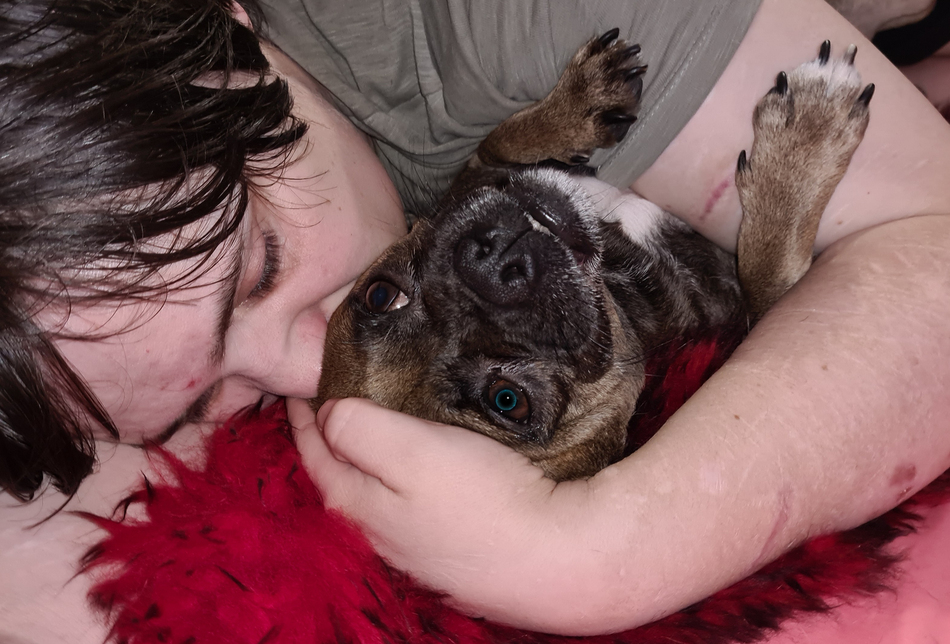
This entry was posted in Dogs on April 27th, 2021 by alisa.deluca
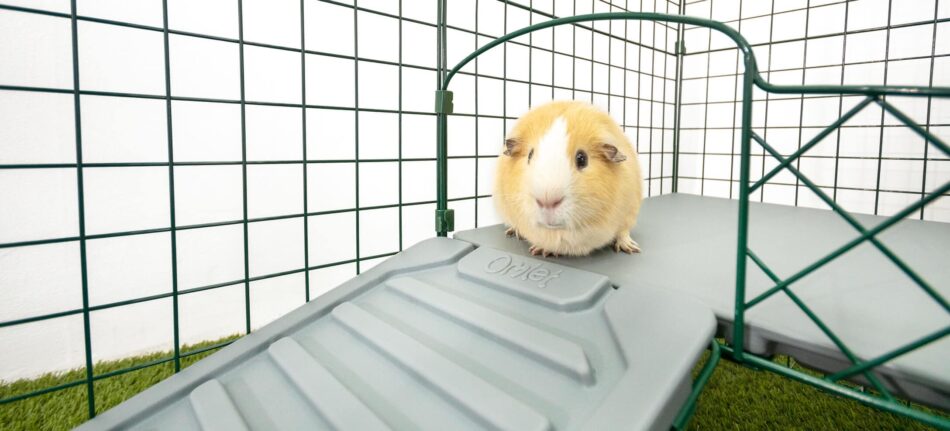
Guinea pigs are highly social animals that thrive on companionship and stimulation. And since a happy guinea pig is a healthy guinea pig, they need plenty of mental and physical enrichment. Toys, treats, and a playmate are just some of the key elements to enriching piggy-play.
Playtime is best spent with pals! If possible, consider adopting guinea pigs in same-sex pairs or trios. Guinea pigs thrive on social interaction, and do best when they have friends that speak their own language! If more than one guinea pig is not an option for you, be sure to engage yourself in piggy-playtime every day. Take note of what your guinea pig likes to do – are they curious and outgoing, or laid-back and shy? Do rolling balls catch their attention? Or do they prefer to chew rather than chase their toys? Knowing each guinea pig’s personality will help create the most enriching environment possible.
Serve food interestingly
Were you ever told not to play with your food? Well, the same rule does not apply to cavies! Mealtimes are a great opportunity to sneak in play and bonding time. Our Caddi Treat Holder is a fun and unique way of serving up your guinea pig’s meals and treats. Making food challenging to reach means more mental and physical reps before reward, and has the added bonus of keeping treats up off the floor. You can also hide food to encourage natural scavenging behaviours in your guinea pig. Place treats in paper tubes, or a hay rack for rummaging fun! Be sure to surround treats with nutritious hay to ensure meals are eaten before dessert!
Guinea pigs can also be fed by hand, but be sure to only offer treats long enough to keep your fingers out of accidental-biting range! Hold treats loosely between your fingertips and release as soon as your piggy has a hold of it.
Another interesting and engaging way to serve food to your cavies is by threading fruits, veggies, or herbs on a rope or skewer stick fastened with knots or clothespins. Be sure that the twine or rope is thick enough to avoid getting knotted around your piggy, and not so long that they can get themselves entangled. A blunt, metal grilling skewer secured to the side of your guinea pig’s enclosure is both chew and tangle-proof.
Guinea pigs are very food motivated, which makes exercising much easier! To give your piggy some extra steps for the day, tie some of their favourite food or toys to the end of a string and drag it along the floor for them to chase! Keep it just out of reach to encourage them to keep after it. Just be sure to let them catch their prize within a reasonable timeframe!
Changing up the menu from time to time helps alleviate boredom while enhancing your guinea pig’s health. Choose seasonal, piggy-friendly fruits and veggies such as melons, apples (without seeds!), or summer squash to add variety to their diets. Guinea pigs are also excellent lawnmowers, and would love time outside to help with the grass! Place them in a secure guinea pig run to move around each day and you’ll be amazed at how much less you’ll need to mow!
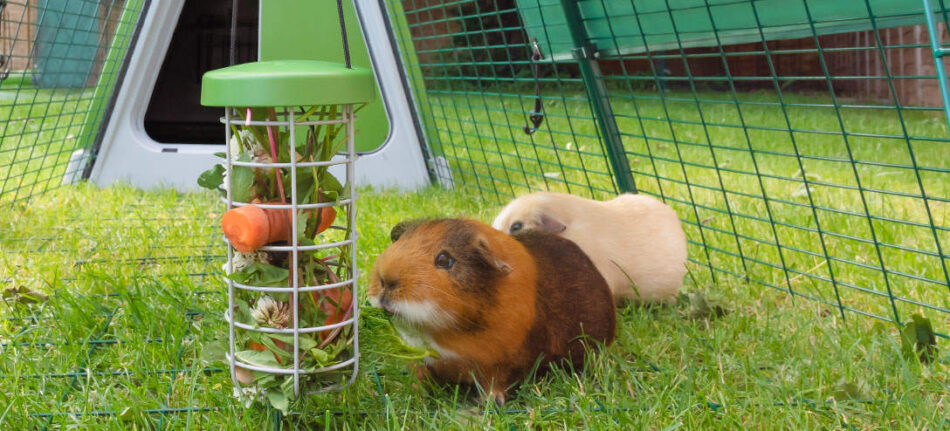
Obstacles, tunnels and tubes
Did you know that wild guinea pigs utilize the burrows and tunnels of other animals? They aren’t known for digging themselves, but they love to spend time in the safety of pre-dug tunnels! As prey animals, they have excellent eyesight – especially toward the sky, scanning for owls and hawks. Guinea pigs thrive in areas with lots of cover supplied by tubes and hideouts. Our Zippi Guinea Pig Tunnel System and Zippi Guinea Pig Play Tunnels allow for hours of play for your piggy and viewing enjoyment for you! Watch your piggy zoom through tunnels (or maybe even take a nap!) and weave their way through a course of your own design. Change the configuration routinely to further challenge your guinea pig. Bonus tip: hide some treats along the way, and you’ll have one happy cavy!
Make use of those shipping boxes! Guinea pigs love a good challenge, so create an obstacle course using a combination of tunnels, tubes, and cardboard boxes. Just be sure to discourage the nibbling of the cardboard obstacles!
Vantage points
While they feel most comfortable in the safety of tubes and tunnels, guinea pigs enjoy a good climb! They’ll routinely scout their surroundings looking for dangers, so giving them an elevated space will help them feel more comfortable. This is another place to get creative! Build platforms from cardboard tubes, boxes, or add our Zippi Guinea Pig Run Platforms to your piggy’s space to add levels of fun.
Toys
Some guinea pigs enjoy carrying or pushing small toys around. Guinea pig toy ideas include: small plastic balls, untreated willow or dried grass weaved-orbs, and small stuffed toys. Specially made guinea pig toys can be found at most pet stores, or choose small balls and stuffed toys from a selection of cat toys. Ensure that any small, glued-on accents are removed to prevent your guinea pig from ingesting something they’re not supposed to! And make sure each piggy has their own toy- they may be sociable, but not every piggy wants to share their favourite toy!
You can also leave toys in their cage for them to entertain themselves while you’re away. Bird toys, or toys made for rabbits and guinea pigs can be hung from the top or sides of your piggy’s cage to provide hours of fun! Be sure to remove any bells from bird toys that are small enough to swallow. Chewing sticks made from applewood are another must-have for cage enrichment. Guinea pigs have teeth that continuously grow, and need to gnaw on wood to keep them trimmed to an appropriate length. Applewood sticks come in a variety of shapes and sizes, most of which are perfect for your cavy to carry around and gnaw on at their leisure!
Shapeable log bridges are another great cage improvement for your guinea pigs. They can be formed into hides to run under, walkways to run across, ramps, dividers…your imagination is the limit! Untreated garden edging works too – just be sure to purchase a material that won’t harm your piggy should they taste it.
Toilet paper or paper towel rolls are great for creating treat-stuffing toys, or cut them down to create pillars for homemade platforms. Wrapping paper tubes are extra-sturdy for cavy construction projects! If your guinea pig is young or on the small side, be sure they can’t get their heads stuck inside any tubes they have access to.
Moving furniture
Guinea pigs need to be kept on their toes for optimal health. Another simple way to create a new and exciting environment for them is to rearrange their furnishings every time you clean their cage or enclosure. Move around their guinea pig shelters, playgrounds and guinea pig viewing platforms, and they’ll set off re-exploring their territory with gusto!
After all of this exhausting play, your guinea pig will probably want to take a well-earned nap. Popular snooze-space options among guinea pigs are fleece hammocks or blankets. These cosy bed options will be a fast favourite with your cavy! Make sure to wash your piggy’s bed of choice in the washing machine or by hand to keep it fresh!
Accessories to avoid
Toys: Watch out for toys with sharp edges, small attached accessories that could pose a choking hazard, or harmful materials such as treated wood. Also be wary of materials such as soft rubber or plastic that pieces can be bitten off of and swallowed.
Exercise balls and wheels: While guinea pigs may look like large hamsters, their anatomy is quite different. Guinea pigs are not comfortable in an exercise ball or wheel, and can seriously injure their backs or feet if placed in one. Ventilation is also important for guinea pigs, and exercise balls in particular do not allow for enough airflow to keep your piggy cool.
Bridges: Guinea pigs are adorable, but not graceful! Make sure all provided bridges either have rails to prevent accidental falls, or are low enough to the ground or level below them to provide a safe place to land.
Leash/harness: A walk may sound nice, but even the most friendly and trusting guinea pigs can panic on the end of a leash. Cavies are “flight” animals by nature, and will harm themselves struggling against a harness or leash if pulled on. A better option would be playing the string-drag game mentioned earlier, or a snuggle session on the couch with their favourite human-friend!
Creating fun games and environments for your guinea pig is rewarding for both of you! Playing with your piggy builds trust, and there’s no faster way to their hearts than through food! By treating them often, playing even more often, and giving them ways to entertain themselves while alone, you’ll ensure they’re living their best life!
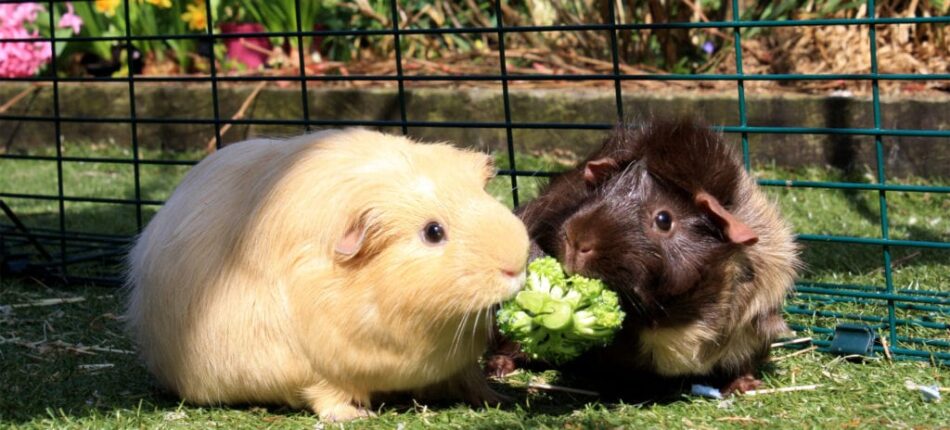
This entry was posted in Guinea Pigs on April 27th, 2021 by alisa.deluca
Budgies are extremely affectionate pets that love to thrive in a family environment. You don’t need to be a bird expert to keep a small budgie under your roof. However, if you want it to thrive and be happy and healthy, there are a few things to consider.
Omlet offers you a list of 5 things to keep in mind when raising a budgie.
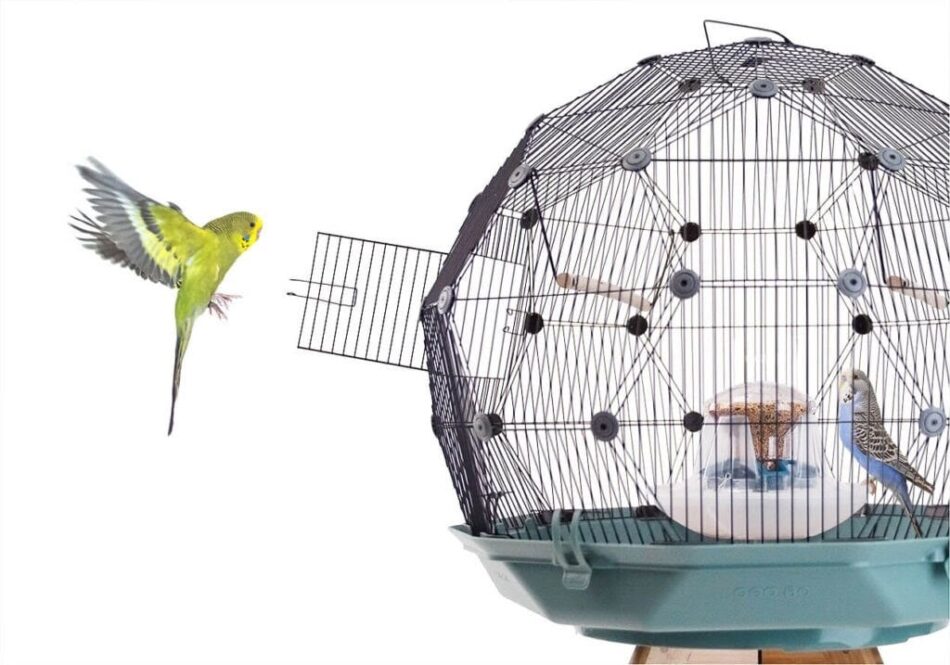
1- Consider investing in a cage that respects your pet and its needs
If you decide to adopt a budgie, this should be a priority. Make sure you have a cage that suits your budgie’s needs and allows it to be happy. A bird needs enough space to stretch its wings and have fun. Make sure the cage is large enough and that it gets enough sunlight. Your budgie will need to see light to be able to thrive.
Budgies fly horizontally and do not fly high, so make sure the cage is wide enough.
It is important to choose a cage that is easy to clean, as you will need to spend time keeping your bird’s area clean. This is essential for your bird’s health (and yours). Budgies need to relieve themselves regularly, approximately every 15 minutes, so you need to have easy access to all areas of the cage so that you can clean the entire cage and avoid unpleasant odours and a dirty environment for your little budgie.
You should also consider a cage that can accommodate several budgies. Although budgies can be kept alone, they do prefer the company of their own kind.
The Omlet solution: The Geo Cage
The Omlet Geo Cage for Budgies, Finches and Canaries complies with current regulations to provide your pet with the space it needs. Its innovative design provides a safe and airy living space for your budgies. This cage is the result of many years of research to provide your birds with an optimal environment to keep them happy.
This cage not only meets the needs of your budgies but is also functional and can be cleaned quickly and easily. The inside of the cage will be as good as new after your visit. In addition, The Omlet Geo Cage for Budgies, Finches and Canaries offers an exceptional design that allows it to be integrated into any interior decoration.
The cage is extremely important, as is its location. Remember to place the cage in a room with stable temperatures: not too hot, not too cold. Also, avoid rooms that are too noisy with too much traffic and activity. Your birds need peace and quiet. A bright room will make your little budgie happy. However, avoid placing the cage too close to windows, as the sun through the glass and the intense heat can be dangerous, or even fatal to your pet.
2- Don’t skimp on accessories
Taking care of your budgie is not only about giving it a place to sleep, it is also about allowing it to have fun and discover many things through a variety of accessories. The bathtub is not a trivial accessory: budgies love to stay clean. There are many plastic tubs available that allow your budgie to clean itself and feel clean all the time. Choose a bathtub that fits your cage and can easily be installed in it. It should be easy to fill from the outside.
At Omlet, we offer a Geo Bird Bath that fits our Geo cage and its sloping sides perfectly.
Technique for the bathtub: do not fill it to the brim, as you will find water everywhere. The tub should not be too small to allow your bird to enjoy it fully, but it should not be too large either so that it does not take up all the space in the cage. If the bathtub you have chosen fits easily into your budgie’s cage, you may want to consider adding it for a few hours while your bird takes a bath and removing it the rest of the time.
You should also consider quality drinkers and feeders that will allow you to feed your beloved animals properly and without hindrance.
If your budgie can clean itself and stretch its wings, it is likely to thrive and feel happy. However, it is necessary to keep it occupied with toys.
So think about furnishing its space with useful accessories that entertain your budgie. Vary the shapes, sizes and aspects to offer your pet new experiences.
Perches for budgies are extremely important for your birds and play a significant part in ensuring a better lifestyle. Choose perches with a wooden base, such as pine, as plastic fails to offer the proper grip that your bird needs, and can be bad for their feet.
Bird toys have their place in your pet’s cage, but avoid taking up the whole space. It is important to have several types of toys that you can mix up weekly to give them more variety and keep your bird entertained.
Toys stimulate your pet and prevent your budgie from getting bored.

3- A happy budgie is a well-fed budgie
There are several ways to take care of your budgie and the first way is to feed it sufficiently with quality food. What does a budgie eat? Your budgies’ favourite bird foods are seeds, vegetables and fruit. Just like other animals, dogs, cats (etc), never give your budgies chocolate and caffeine.
It is essential to ensure that the drinker is always full of water to keep your animals properly hydrated. Your birds will know how much water they need but it must be available to them. If the water is not drunk, you must change it regularly to prevent the growth of bacteria.
4- Budgies need quality sleep!
Sleep is essential for your bird. It allows your pet to rest its body and recharge its batteries. Just like human beings, sleep helps reduce stress and promotes your pet’s learning and memory. It is estimated that a budgie can sleep between 10 and 12 hours a day. A happy budgie is one that benefits from this rest time in the best conditions.
It usually prepares for bed half an hour before going to sleep. You can improve the sleeping conditions of your budgie by providing an opaque blanket, which does not let light in and ensures that your bird gets the rest it deserves. This solution also allows you to soundproof the cage a little if there is regular activity in the room. It is sufficient to keep the room dark and to let a little light through so that your budgies are not injured if they hear a noise that wakes them up. The Omlet Geo Bird Cage Cover offers your birds an ideal solution for a full and restful night’s sleep. It can be placed on any cage and allows your birds to sleep safely.
Establish a routine each night so that your budgies feel comfortable and understand when it is time to go to bed. They will feel confident that there is nothing to worry about and will fall asleep peacefully.
However, if you notice that your budgie(s) panic when you put the blanket on the cage, don’t persist. Some birds have their own habits and there is no point in insisting on certain accessories. If your budgie is happy and can sleep perfectly and peacefully without a cover, that is the main thing.
5- Give your budgie lots of love and get it used to its environment
For a budgie to be happy and healthy, nothing is more important than the love you give them in a healthy environment adapted to their needs. Never rush your budgie and give it time to adapt to any situation, new environment, new toys or accessories…
Don’t hesitate to talk to your budgie and make it feel your presence without smothering it. Repeat its name to get it used to the sound and to assimilate it. If there are several of you in the family environment, introduce the members of your family little by little without rushing your pet. No loud noises or big movements. Your friends or family can enjoy your budgie, but calmly and respectfully.
Treats and time with your pet will make your budgie happy. Make sure you spend time with your budgie. This will strengthen the bond between you. Gaining your pet’s trust is a long-term process. You can use your fingers to tame your pet little by little, for example by moistening them and placing seeds on them. Intrigued and curious, your budgie will surely come to you.
Do not hesitate to open the cage from time to time to let your bird fly in the open air in a room. Just remember to avoid bright lights that may attract your bird and end up hurting it (sunlight through a window, for example). If you decide to let your bird fly in your home, be careful with objects that could either break or hurt your pet. The room should be secure enough to prevent your budgie from ending up in the vet’s office.
An unhappy bird may become aggressive or develop health problems. This can manifest itself in regular pecking or screaming. Your budgie, if unhappy, may be more agitated than usual. If you are sure that you have done all you can to keep him happy and his aggressive behaviour persists or you detect abnormal problems, it is time to make an appointment with the vet. One visit per year to the vet is recommended to check that everything is going well with your pet.
With all these tips and tricks, your budgie can be happy and thrive by your side. All you need is patience and the right equipment and accessories for your pet’s needs.

This entry was posted in Budgies on April 24th, 2021 by alisa.deluca

Rabbits are usually peaceful creatures who love to play and socialise with their owners. But what do you do if your rabbit starts showing signs of aggression? It’s tough to see your pet stressed, and it’s natural to want to help them. Here, we outline a few ways you can minimise bad bunny behaviour and start enjoying the time you spend with them again!
What is aggressive behaviour in rabbits?
There are two major kinds of aggression in rabbits, the most typical being defensive behaviour surrounding their habitat. If your rabbit bites when you reach your hand into their cage or hutch, it’s likely to be territorial defensive aggression. Another kind of aggressive behaviour occurs between your rabbits – for example if they are fighting each other to the point of injury.
It can be upsetting to see your bunny get hurt, and hard to know what to do. A small amount of fighting is natural between your pets, but if you can see blood on their fur or in the hutch then it’s possible that the anger is getting out of hand and the bites are getting nasty.
How to help with territorial aggression and biting
If your rabbits bite your hand – or try to – consider how and where you approach your pet. The hutch is often a bolt hole and ‘safe space’ for a bunny and is where they spend most of their lives. If you reach in unexpectedly, it is natural that they might be scared and defensive. Rabbits are prey animals in the wild and are especially jumpy when ‘cornered’ in their safe space!
You may find that if you start to interact with your rabbit in a non-hutch setting – such as a run or play area – you have more chance of a peaceful and happy interaction. Try sitting with your rabbit in the run for a few hours every day, and then begin to slowly approach with your fluffy friend’s favourite rabbit treats. After spending time like this, you may find that your rabbit starts coming to you more and more, and if the rabbit is initiating the approach, aggression is much less likely.
By spending time with your rabbit in this non-hutch environment, you are teaching your pet that you are not a predator, and that you can be trusted to approach them. Once the trust is established, you should be able to approach the rabbit in its rabbit hutch with no problems.
How to stop aggressive behaviour between your rabbits
If you have noticed fighting between your rabbits, and if this seems to be more than just their normal play fighting, you may need to think about how much space they have in their hutch. It could be that your rabbits have grown since you bought them, and their once spacious house is now a little too small for two. It could be that they have spent little time in the run over winter, and so they’ve become a little ‘house-bound’ in their hutch. Cabin fever affects humans and pets alike!
Whatever the reason for the bunnies’ bad moods, it is important that your rabbits should feel happy and relaxed in their hutch. The fighting will likely ease off if they have more elbow room. Rabbits are territorial animals, and they each need their own space as well as a shared space.
Try distracting your brawling bunnies by clapping your hands. The noise will distract them and will hopefully teach your rabbit not to fight. A particularly aggressive rabbit can be deterred by spraying water on their nose – but this isn’t something you want to be doing too often, so if, after the first few sprays, it isn’t making any difference, it’s time for Plan B.
If you decide to invest in a larger hutch but your rabbits continue to show aggressive behaviour, you may have to separate them into two different hutches. That’s Plan B!
The benefits of spaying rabbits
Spaying (also known as neutering) is the term for stopping your pet from having babies and is accomplished via surgery. If your rabbits were from a pet shop, it is likely that they have already been spayed – but if you got your rabbits from a friend, it’s always a good idea to take them to the vet and ask about spaying.
If your rabbit has not been spayed, they are much more likely to exhibit aggressive behaviour to you and any fellow bunny who shares their hutch.
It is common for owners to keep male rabbits or female rabbits in single-gender pairs, and this can lock them into a mating-related feud that neither can win. Your rabbits could be fighting over who is the most dominant in their shared territory, but this fighting is much less likely to occur if they have been spayed.
Equally, if you have decided to keep a male and female rabbit together, it is a good idea to get them spayed, as rabbits can have up to fifty baby bunnies a year! Fifty bunnies may sound cute but consider how difficult it could be to care for and house that many animals!
There are other benefits to spaying your rabbit other than reducing their aggression, such as reducing their chances of getting mammalian, ovarian or testicular cancer. Spayed rabbits are also much easier to train, and are more sociable generally.
If you have only recently brought your pet rabbit home, they may need a little time to get used to their new space and become comfortable. It is natural for any new pet to be nervous and skittish at first, and this could lead to a few aggressive behaviours, including biting, early on.
It’s important to know that your rabbit is more scared of you than you are of it, and that just because it has bitten you doesn’t mean that you won’t end up being the best of friends! If you feel nervous about establishing contact with the rabbit, talk to a friend who has had rabbits for a little longer, or check out some of the reassuring ‘how to’ guides available online.
Just remember that having a rabbit is hugely rewarding and it’s worth spending time hand-training your pet from the outset. As long as they have enough space and no aggressive ‘mating rivals’, they should be every bit as calm and cuddly as you could hope for.

This entry was posted in Rabbits on April 22nd, 2021 by alisa.deluca
 It can be tricky to decide whether or not your dog should wear a collar or a harness for walks. A lot of it depends on your dog himself, from the breed to his age and activity level. No matter what type of breed you have, one thing’s for sure, they all need to go out on walks! The main two types of leash attachments that you can use for your dog are harnesses or collars.
It can be tricky to decide whether or not your dog should wear a collar or a harness for walks. A lot of it depends on your dog himself, from the breed to his age and activity level. No matter what type of breed you have, one thing’s for sure, they all need to go out on walks! The main two types of leash attachments that you can use for your dog are harnesses or collars.
Whether you just got a new dog and aren’t sure which to use, or you are looking to switch things up, it’s important to know the pros and cons for both dog harnesses and collars before making a decision.
Collars
Pros
Dog collars are the best when it comes to controlling aggressive dogs, puppies or dogs who are in training. It gives confidence to the owners where they can let their dog walk without any fear. It comes with many direct benefits while providing better control to the handler. Dog training is one of the most important reasons for buying a dog training collar. It is one of the first dog training tools that an owner would need. It helps your dog to successfully overcome obstacles. It also helps to guide your dog and secure his attention if it has a short attention span.
Your dog may get a bit rowdy during the walking session. It’s the dog collar that can correct its behaviour when it is misbehaving. Dogs can go on jumping fences, playing in woods, or getting into mischief; so, you should consider durable dog collars with breakaway fasteners.
The main benefit of collars is that it’s more convenient than a harness. They can be left on at all times as opposed to a harness, which should only be worn during walks and it’s much easier to snap a collar on and off than a harness.
Another great benefit of wearing collars comes with the metal ring where you can attach your pet’s ID tag or name plates with your address, your phone number, veterinarian office phone number or the tag of the dog registration organisation where your dog is registered for identification in case he or she gets lost.
Are you a fashionista or do you love to express individuality? You can even use a bow tie or bandana/scarf as an attachment for the collar.
Cons
What can go wrong when you lead a dog by the neck? Quite a lot, it turns out.
The safety of your dog’s neck plays a vital role here. If dogs constantly pulls against their collar, they can injure themselves or reduce the airflow they are getting. Some smaller breeds, like miniature dachshund or poodle, are prone to collapsing tracheas, and a rough tug on the collar can quickly turn into an emergency situation.
Other dogs’ necks are as thick as their heads, e.g. pugs and whippets, so slipping out of a collar is effortless. Even if you have a tough mutt or working dog, repeated pulling on the neck can lead to thyroid damage or spinal injuries over time. Please avoid using collars to walk dogs with medical issues such as glaucoma, a history of proptosed eye, neck injuries, or spinal malformations.
Collars should also not be used on toy breeds and brachycephalic breeds, such as Chihuahuas, Chinese Crested, Italian Greyhound, Maltese, Toy Poodle, Yorkshire Terrier, Bulldogs, French Bulldogs, Boston Terriers, Pugs and Boxers.
Harnesses
Pros
The main benefit for using a dog harness instead of a dog collar is the control you have over overly excited dogs. If it comes to safety and security, harnesses are generally better at preventing accidents because they fasten more securely around your dog’s body and are simply the most secure, and most comfortable way to hook your dog up to his leash. It covers your dog’s chest, shoulders, and upper back, which disperses pressure over a larger surface area whereas collars give you better control over your dog. While dogs can easily slip out of their collars and potentially run into traffic or another person’s yard, harnesses offer much more security and safety.
A good harness will reduce pulling, increase your control over your pup, and decrease stress on his neck and joints. Bonus points: because it secures closer to the dog’s centre of gravity, a harness gets tangled in the leash less and helps prevent jumping.
There are different kinds of harnesses, starting from cool, cute or practical, such as bags where you can put some treats or eco-friendly waste bags
When it comes to specific breeds or diseases, a harness has a better function for your dog:
- Brachycephalic breed: These breed dogs typically have flatter faces, “shortened head” and refers to the short nose and flat face of dogs like Pugs, Shih Tzus, Chihuahuas, Chow Chows, Pekingese, French Bulldogs or Bulldogs. Respiratory issues may be better managed with a harness.
- Tracheal collapse: This is a medical condition where the trachea will fold in on itself causing trouble breathing and a cough. Please avoid using a collar because it applies further pressure and can even worsen the condition.
- Risk factors for spinal problems: A condition called intervertebral disc disease (IVDD) makes long-bodied breeds such as dachshunds very prone to slipped disks. By using a harness you can take pressure off the neck and back and help prevent further damage.
- Orthopaedic disease: Dogs with orthopaedic disease can have a hard time getting up to walk so a harness can help you get them up and move around more easily.
Cons
Harnesses are just less convenient than collars for hoomans. A collar can just slip on, but harnesses take more time to fasten.
Harnesses can be uncomfortable: Harnesses are bulkier than collars, so they can be more uncomfortable for your dog. Some dogs really don’t like wearing harnesses, so it can take some time for them to get used to it.
Harnesses may not have a place for carrying an ID tag. It’s best to get a harness with a ring for a tag—or use both a collar with a tag and a harness when out walking.
If your dog wears weather protection or due to some illness needs to wear clothes, a harness might be a bit more of a disadvantage than a collar. The clothes might cover the harness ring(s), so that you’re unable to put a leash on. Alternatively you can attach the harness over the clothes but make sure -in general- it’s neither too tight nor too loose.
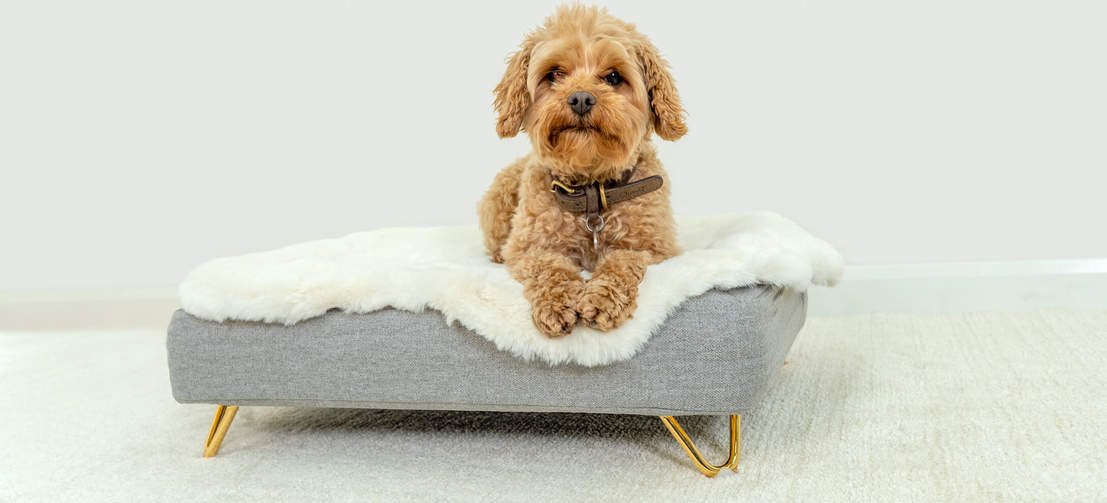
The Sheepskin Topology Topper provides dogs with a luxurious place to rest.
Summarising
So, collar or harness – which one is now the better option for your dog? There is no general answer to this question as it always depends on the breed and health of your pooch and the use of the item. But please, always keep in mind:
- Collars are less restrictive on movement, which is good for working dogs who are running around all day. Collars are also better for dogs that don’t pull and can calmly walk by your side.
- Harnesses are better for overly excited dogs as you have more control over them.
- Smaller dogs and brachycephalic breeds should avoid wearing a collar.
- It is absolutely advisable to get your puppy used to both, collar and harness.
- If you want to transition an older dog or even a pup from collar to harness be patient – the adjustment phase may take some time. Bring some treats along on your first few harness walks to distract your dog from that unfamiliar feeling, as well as associate the change with positive rewards.
- It also depends on the use of the item. If you want to have a walk with your buddy or take a ride with him in your car (to fasten the seatbelt), it is recommendable to use a harness. If you just let him out in the garden or take him to your friends’ house, a collar is totally fine – same goes with dog kennels.
To sum up, harnesses are usually the best choice for walking dogs because they don’t put pressure on the neck. But collars are generally more comfortable and have a place to hold an ID tag. At best, let your buddy wear both: If you can’t attach a tag or name plate to the harness, use a collar for the ID tag and a harness for the leash.
This entry was posted in Dogs on April 21st, 2021 by alisa.deluca

This article is a part of our Pride of Omlet series, a collection of amazing stories which shine the spotlight on extraordinary pets and share their selflessness, bravery, talent and compassion with the world.
-Written by Anneliese Paul
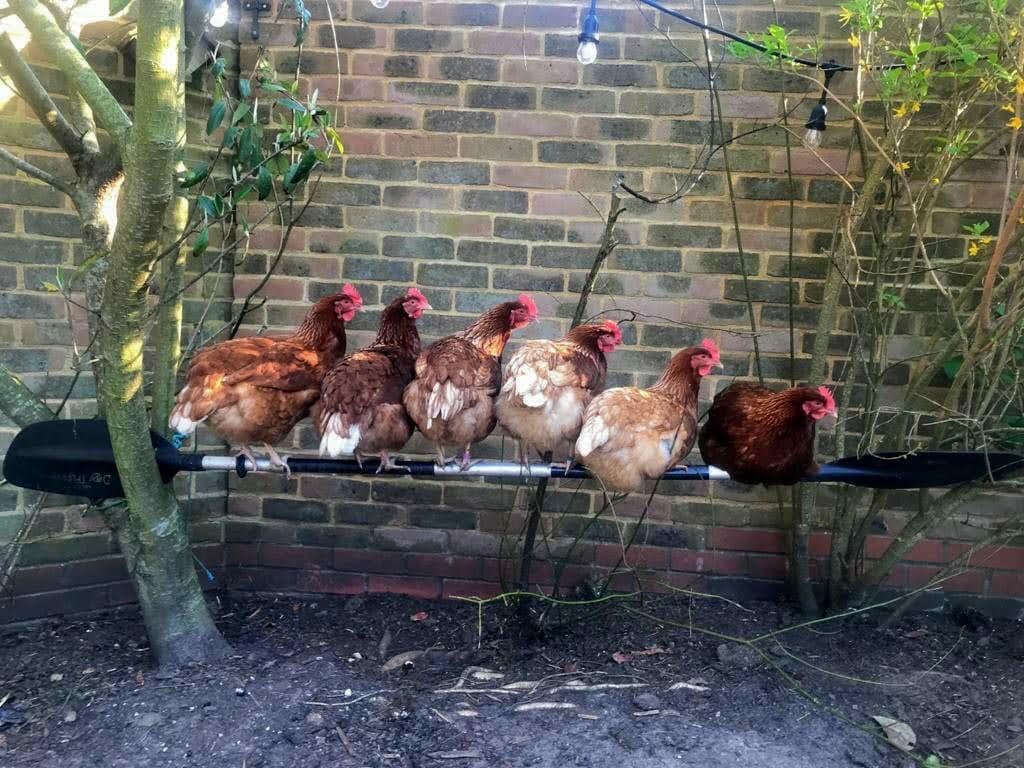
Henni Hen is a teaching assistant by trade. A cute and cuddly chicken who loves children. She follows in the footsteps of her bubbly humans, Hamish and Verity.
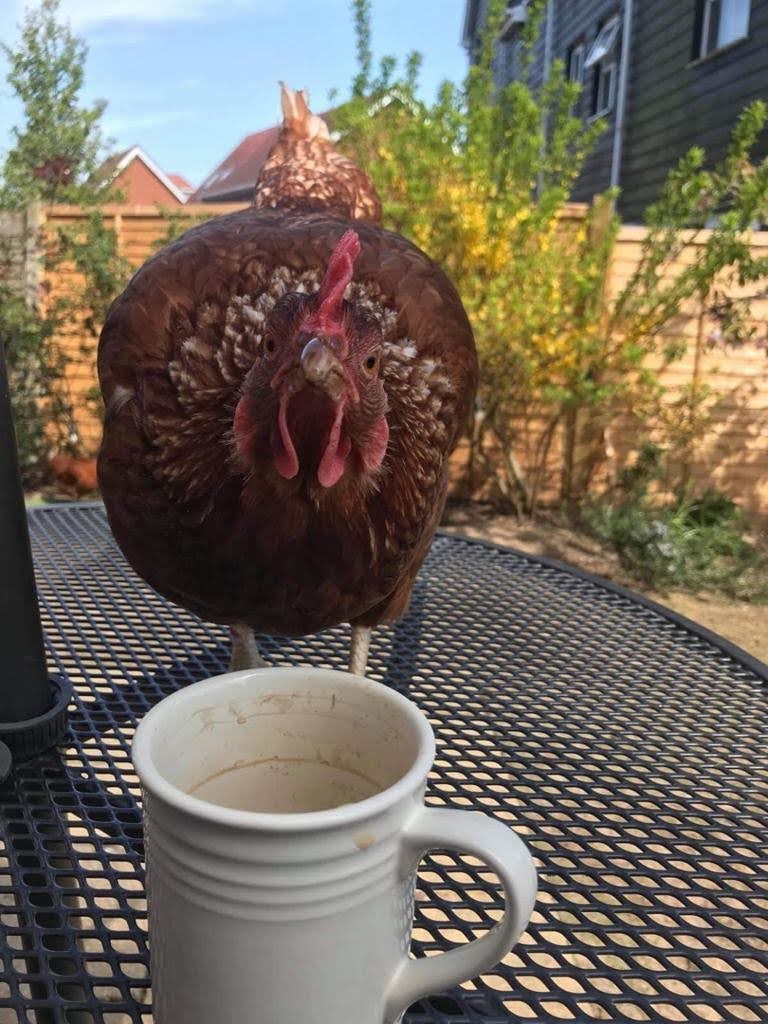
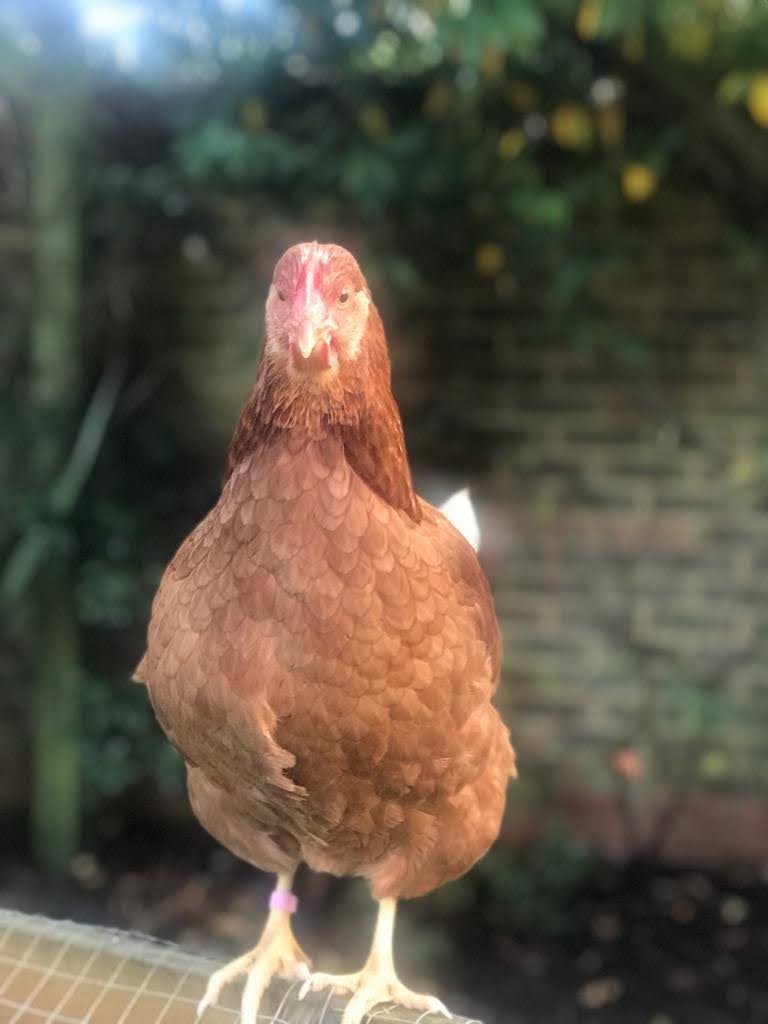
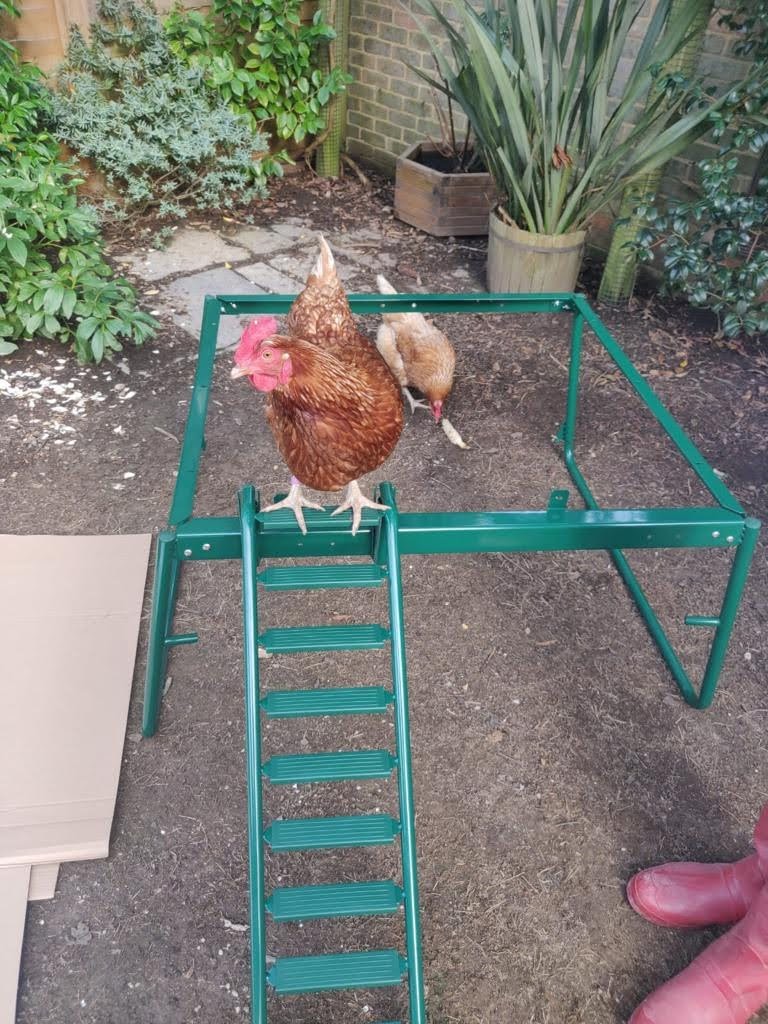
Verity hatches chicks in an incubator every year at the primary school in Kent, where she works as a reception teacher. It’s a highlight for the children in spring, with lots of learning opportunities and fluffy little chicks make Easter even more special.
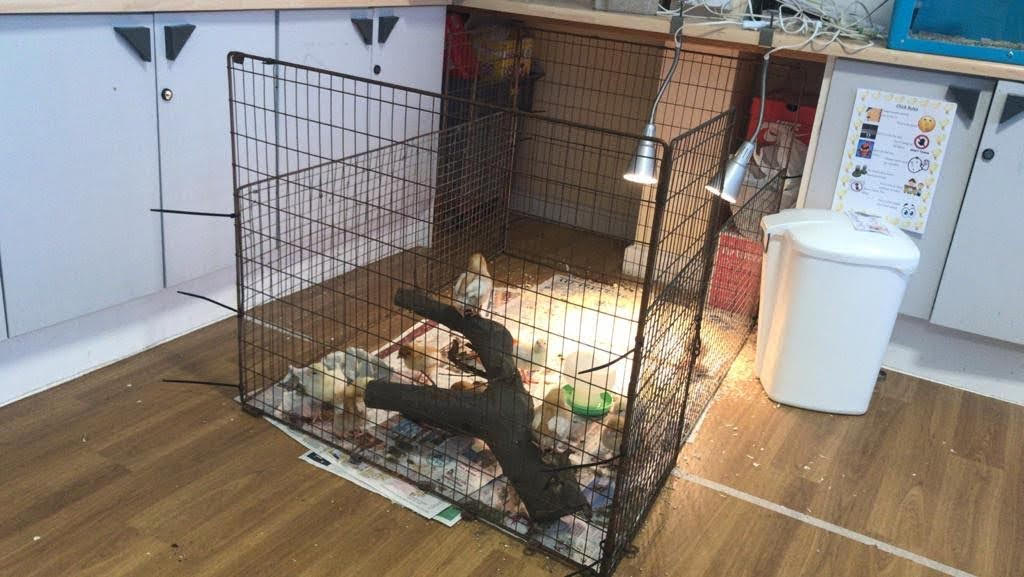
It was natural for Henni to become a teaching assistant at an early age. She was, after all, born in a school. Henni helped the children with topic work and became the subject of many good literacy and science lessons.
But Henni’s talent lies in her ability to help children read. Henni can’t read herself, but children who wouldn’t usually read to an adult began taking Henni to beanbag in a quiet corner where they could get cosy. Henni cuddles up and listens patiently to her young reader, giving the odd encouraging cluck.
When Henni and her sisters became too big for the classroom’s hutch, Verity and Hamish moved into a house with a garden. Instead of rehoming the chicks with local farmers (like they usually did), they decided to take Henni and her sisters home. They’d been talking about getting a dog, but both working full-time, the chickens seemed like a good option.
Most of the time, Henni is outside, like an ordinary chicken, scratching in the garden or getting up as high as she can. But Verity and Hamish potty trained her because she loves coming into the house for a cuddle, and of course, she needs to work.
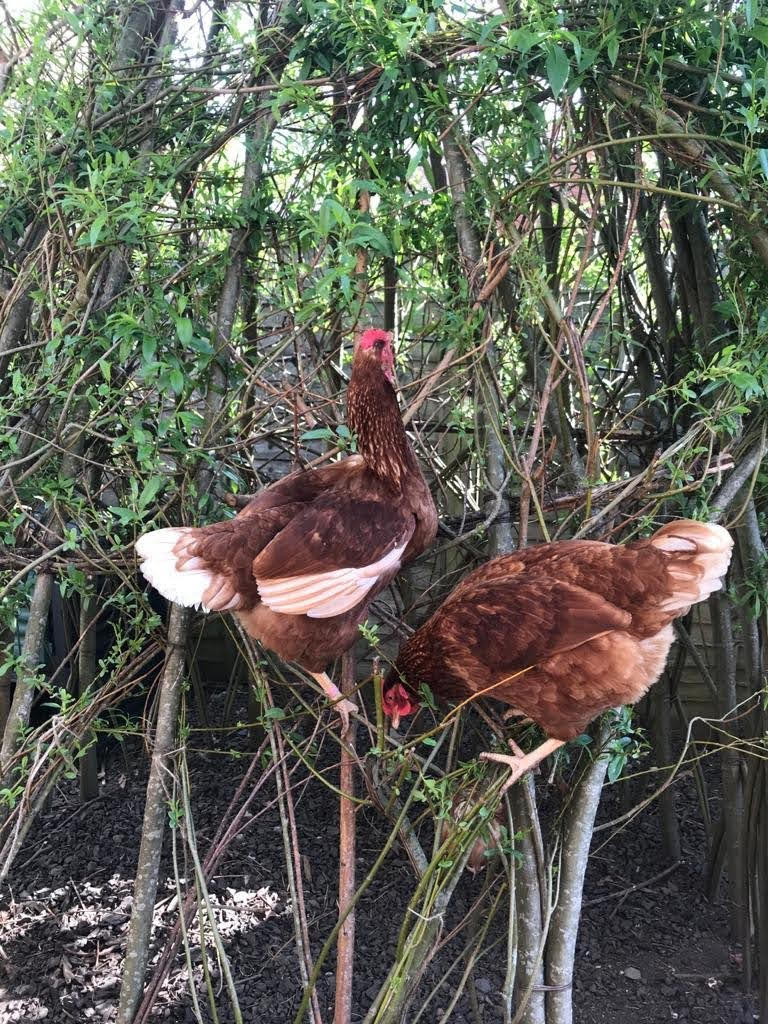
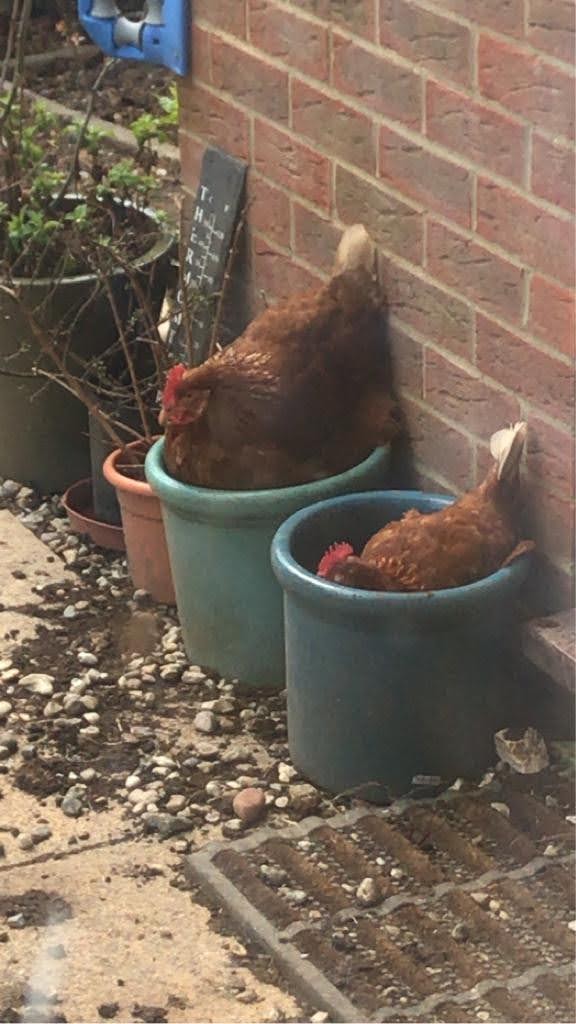
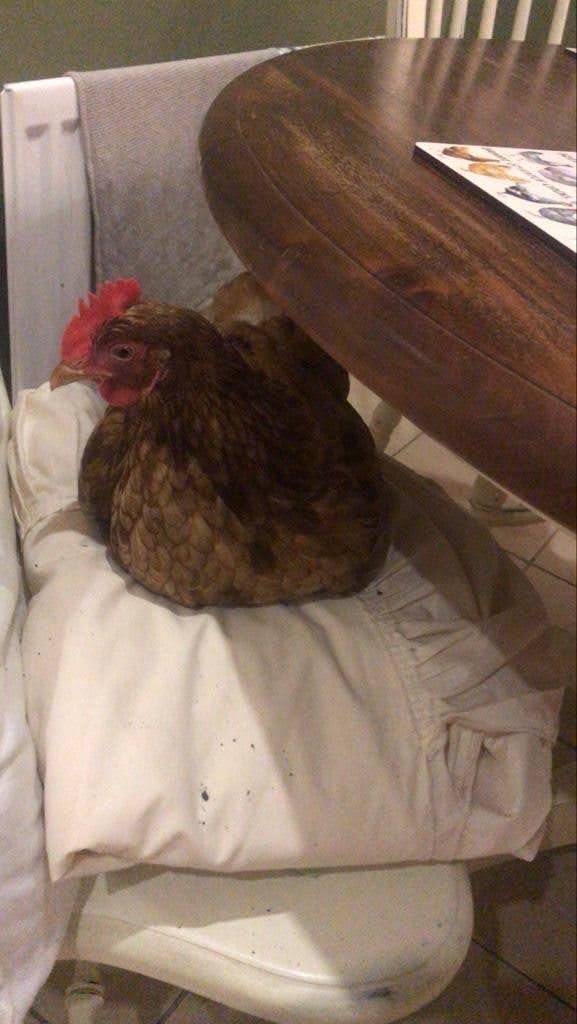
During the lockdown, the children missed holding Henni. So, Henni sprang into action and delivered both live and recorded lessons from the study that she shares with Verity. Verity read children stories, and Henni sat on her shoulder, making sure the children were listening. The deputy head called Verity regularly to make sure Henni’s doing ok.
Being a caring soul, Henni also gave to the community over lockdown. Together, Henni and her sisters lay six eggs a day, so Henni and Verity decided to do a doorstep delivery service for their neighbours. At 10 am, Henni would lay an egg and make a lot of noise about it, so all the neighbours knew when their eggs are ready. Then, Henni would hop onto Verity’s shoulder, and together they delivered eggs to all the houses on their close.
When she returned home, she’d often hop onto her favourite perch (the top of the garage), and the children from the neighbourhood would come over to Verity and Hamish’s to see “the one on the roof!”
Henni and her sisters Megg, Gertie, Margot, Ginger, Rona and Nora used to live in a wooden coop in the garden and come into the garage in winter when it was cold, but Verity and Hamish wanted the best for them. So last year, they got a new home, an Omlet Eglu Cube, and now they’re cosy outside all year round.

But Henni still likes to come inside for a cuddle and can often be found sitting on the sofa between Verity and Hamish for a family film night after a hard week at work.


She’s just an ordinary brown chicken, and she’s low in the pecking order, but she’s got high hopes for the world. She’s very special to the children she teaches and the community she lives in, and of course, to her humans Verity and Hamish. She’s worthy of a gold star for an outstanding effort.


This entry was posted in Chickens on April 20th, 2021 by alisa.deluca
Everyone loves to stroke, cuddle and pamper their pet. Their fur is soft and warm, and stroking a dog or cat can help humans relax and destress. But despite these positives, your pet’s loose hair can invade your living space, settling on carpets, sofas, beds and furniture. It can be difficult to get rid of. So how can you avoid spending hours cleaning up after your pet?
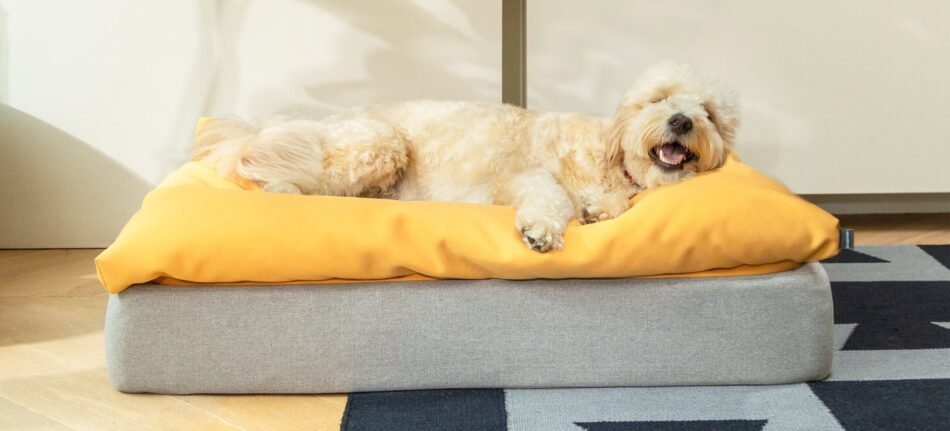
Removing fur to help pet allergies
Do you often have red, swollen eyes, a runny nose and experience persistent sneezing? If so, it could be because of your pet’s fur. Did you know, 40% of European cats are carriers of a bacterium: Bartonella henselae? Researchers thought that this bacteria could only be transmitted through your pet’s scratch, but numerous studies have shown that the bacteria can be transmitted through fur and fleas. This is why it is important to treat your pet and wash your hands after petting it.
Pets affect the quality of the indoor air we breathe. Hair and saliva carry allergens and can cause nose, throat and eye irritation, asthma and breathing difficulties.
So how do you deal with pet hair?
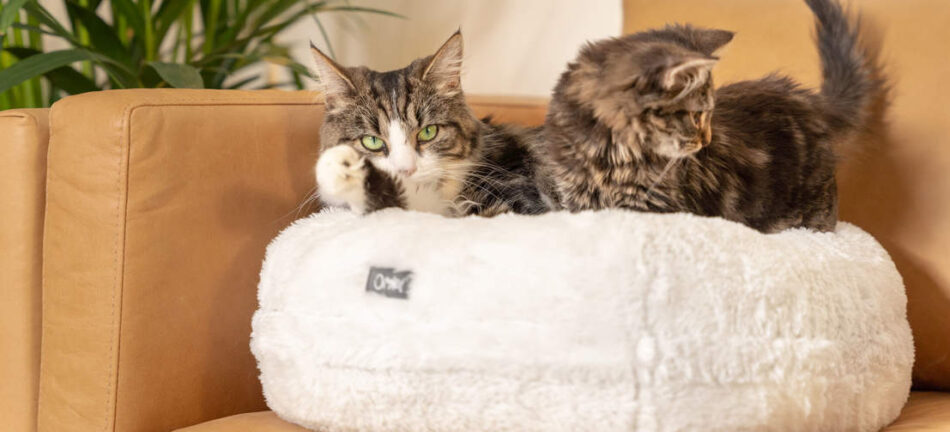
Useful techniques to get rid of hair
Removing pet hair from your home doesn’t have to be a time consuming task. Here’s a few tips and tricks to try…
Brush your pet’s hair regularly, preferably outside, but if that’s not possible, an easy clean area such as the bathroom may be just right. By brushing your pet, you allow it to shed any hair that may have otherwise fallen onto your sofa or other surface in your home. You can gather the hair in one place and you clean it up much more easily and quickly.
Protect furniture and areas where your pet likes to lounge. Your furry friend is bound to have a special place where he likes to spend time napping and grooming, and these areas can become loose fur hotspots! Try covering your pet’s favourite patch with a towel or blanket.
The ultimate appliance: the hoover. Cleaning your home is essential in normal times, and even more so when you have furry pets. This solution seems obvious and yet it is radically effective. Choose a hoover over a broom. A broom tends to make the hair fly around and instead of getting rid of it, you move it around to other surfaces. You can also vary the end caps to suit all surfaces.
Use dishwashing gloves! An original but effective tip. Use a pair of washing-up gloves to pick up your pet’s hair in a circular motion from the desired spot. The hair will stick to the glove and can be rinsed away.
Use moisture to quickly gather the hair into small balls. Take a damp sponge or flannel and wipe the desired area. Some of the hairs will cling to the sponge while others will clump together. This method should be combined with other techniques to effectively remove your pet’s hair.
The well-known method: the adhesive roller. Using an adhesive roller is particularly effective on your clothes, especially if you do not want to wet them with a sponge. The hair will stick to the tape and lift from the material. This technique is super effective on small surfaces. However, the roller soon becomes full of hairs and it is necessary to change the roller regularly if attempting larger surfaces in your home.
Use specific brushes: velvet brushes, electrostatic brushes, etc. There are all kinds of useful brushes on the market. With a simple movement of the hand, they attract the hair to the brush and lift off your soft furnishings.
Static electricity with tights! Don’t just throw away your frayed tights, they can be reused to pick up your pet’s hair. The friction creates static electricity and attracts the hair to the nylon material.
Ventilation: renewing the air to reduce the concentration of hair in one place. Whether you have pets or not, airing your home is essential to prevent the accumulation of dust and bacteria. You will eliminate bad odours and allow for fresh air to circulate the home.
If you really need to keep an area hair-free, the most effective method will be to restrict access to your pet. It may be drastic, but you won’t have to worry about hair in your bedroom causing irritation while you try to sleep, for example.
Your pet’s fur will always be present, and impossible to eliminate entirely, however, these little tricks will help you to considerably reduce the accumulation of hair in your home and allow you and your pet to live in a healthy, comfortable and hygienic environment.
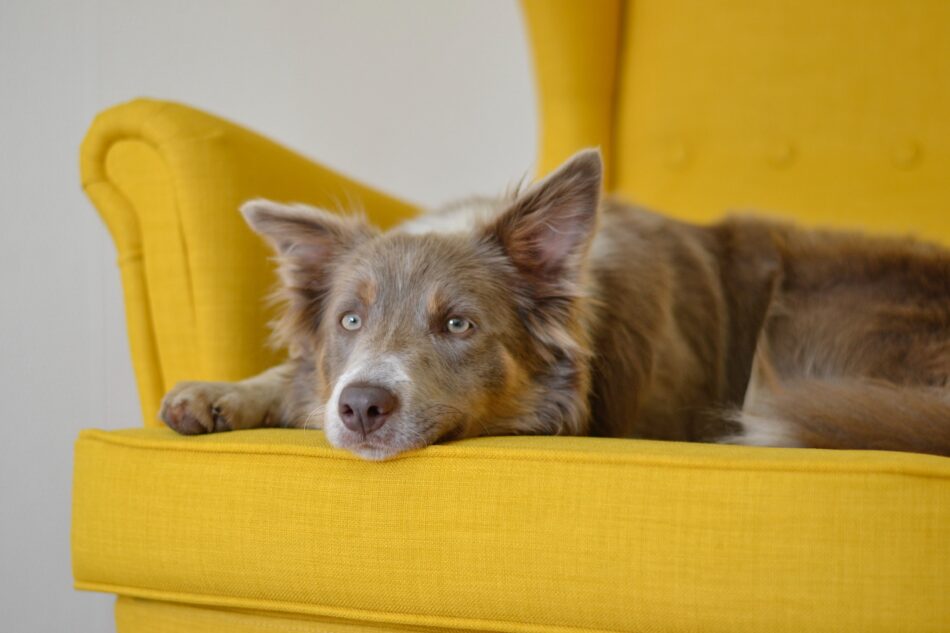
This entry was posted in Pets on April 19th, 2021 by juliakretzner
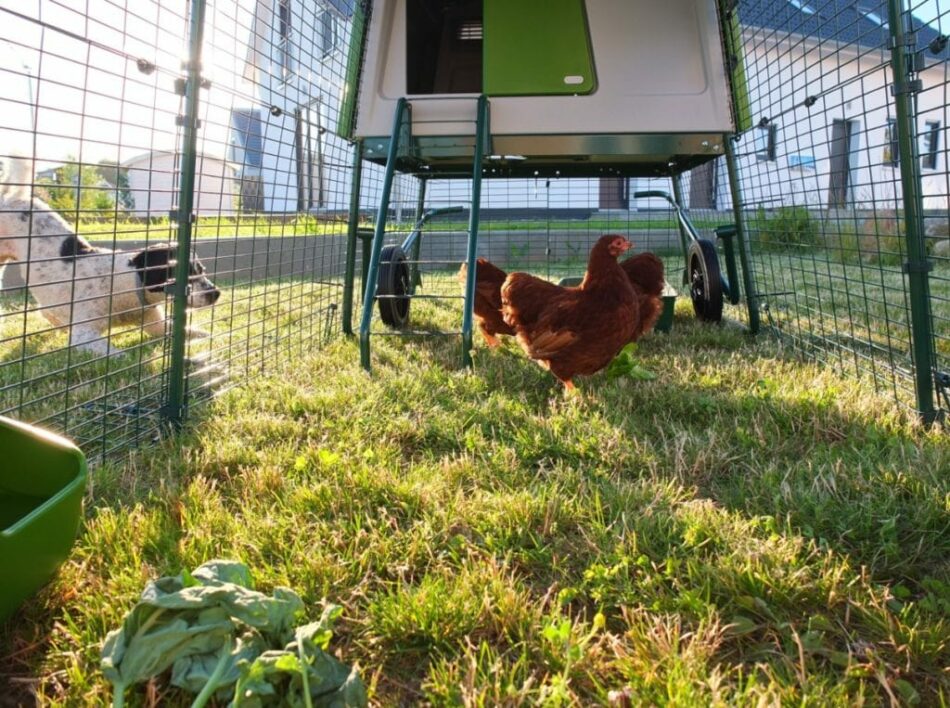
You can keep chickens with other pets when the proper preparations and precautions are in place. Some pets like cats and dogs may have an innate prey drive that chickens can trigger, so it’s important to take introductions slowly to ensure success. With these tips, you’ll be able to confidently introduce your current pets to your chickens, or introduce new pets to your existing flock with confidence.
Keeping chickens with dogs
Dogs are the most common pets in the world, with millions kept as pets across the country. So, if you’re among the many dog owners, adding chickens to your family is possible once you consider your dog’s temperament and trainability.
Assessing your dog
If you’re a dog owner, the first thing to consider is their temperament. Different dog breeds may also react differently to birds as part of their nature. For example, breeds like Labrador Retrievers or German Shorthair Pointers may become easily excited around birds due to their natural hunting and retrieving drives. Other breeds that may have increased prey drives include:
- Beagles
- Sighthounds like Greyhounds or Borzois
- Dachshunds
Regardless of their breed, if your dog becomes excited or overly curious around small animals, their behaviour will likely carry over to chickens. If your dog loses their mind over the birds at your backyard feeder, or drags you to investigate the park ducks on your evening walks, they’ll likely stress out your flock – and themselves.
Dogs without a prey drive or with little interest in birds will likely not pose a problem to your chickens, but all dogs react differently when new pets enter their territory. Usually, most dogs will adjust to the new backyard occupants just fine after an acclimation period. You will likely see your dog expressing interest in your chickens at first – hanging around and sniffing the coop. They may even express a desire to interact with your chickens through playful postures and behaviours. Understanding your dog’s body language around your chickens will help you determine what their relationship will be like.
Chickens are prey animals, and can be hurt easily. Dogs cannot play with chickens as they would with other dogs or even other pets. It’s important to teach your pup that chickens are fragile friends – not toys or something to hunt.
Teaching dogs to get along with chickens
Unless leashed walks make your dog overly excited, their first encounter with your chickens should be done with a dog collar and lead. Make sure their collar is tight enough that they don’t slip out, but not so tight that it’s uncomfortable. Walk your dog up to your chickens’ enclosure and let them sniff. Maintain a tight leash until you see your dog’s reaction, and allow the lead more slack slowly to reinforce good behaviour.
Let your dog watch you spend time with your chickens. This should be done with your chickens in the safety of a strong walk in chicken run. If your dog does more than sniff or hang around the run, take a step back and approach their interaction from a different angle.
It could take several weeks for your dog to fully accept your chickens. Some other ways to help your dogs adjust to your chickens include:
- Setting up chicken fencing around the outside of your flock’s run for your dog to observe them at a distance.
- If your dog has a run or playpen, place it next to your chickens’ run and slowly decrease the distance over several days until they are side-by-side.
- Reward your dog with their favourite treats each time they are calm around your chickens.
Make sure to never leave your dog unattended with your chickens – especially in the beginning. Even if they can’t get into the run with them, an excited dog’s barking can easily stress your flock out.
Keeping chickens with cats
Cats are more difficult to train than their canine counterparts, and are decidedly less predictable in their behaviour. But the good news is that most cats don’t see a large hen as potential prey the same way a dog might. Most cat owners will agree that their cats show little to no interest in their chickens. In fact, cats and chickens have a somewhat symbiotic relationship.
Birds and their feed attract rodents, which a cat would much prefer over your hens. So, when your cat is able to patrol your chickens’ surroundings, chances are good that any potential rodent problem will be nipped in the bud.
Some cats may show increased interest in your hens. This largely depends on your cat’s breed and temperament. Cats will pose a greater threat to chicks rather than grown hens, but by keeping your flock in a strong chicken coop and run, you’ll ensure they stay safe from your cat.
Keeping chickens with guinea pigs
It may be tempting to keep some cute cavies in with your chickens, but in reality it’s not wise. Chickens will likely pick on them, and with their short legs, guinea pigs can’t get away from them quickly. Their dietary requirements are also very different, and your chickens may eat your guinea pigs’ food in favor of their own, which means neither animal will be getting the nutrients they need. If you have cavies and want to house them near your chickens, it’s best for them to have their own guinea pig hutch and run.
Keeping chickens with rabbits
Rabbits on the other hand are fast enough to fend for themselves against chickens, and if raised together from a young age, can do well around chickens. Still, they require their own dietary needs and clean sleeping quarters. They don’t roost like chickens, so they’ll need their own burrowing space in the run or under the coop.
The easiest way to achieve this is by adding walk in chicken run partitions. This will allow you to create “rooms” for each species to ensure they all get what they need. You can open the partition doors to allow everyone to be together whenever you’d like, or create a third space as a common area.
Remember to try to give each species as much space as possible in their respective areas to make them feel safe and comfortable.
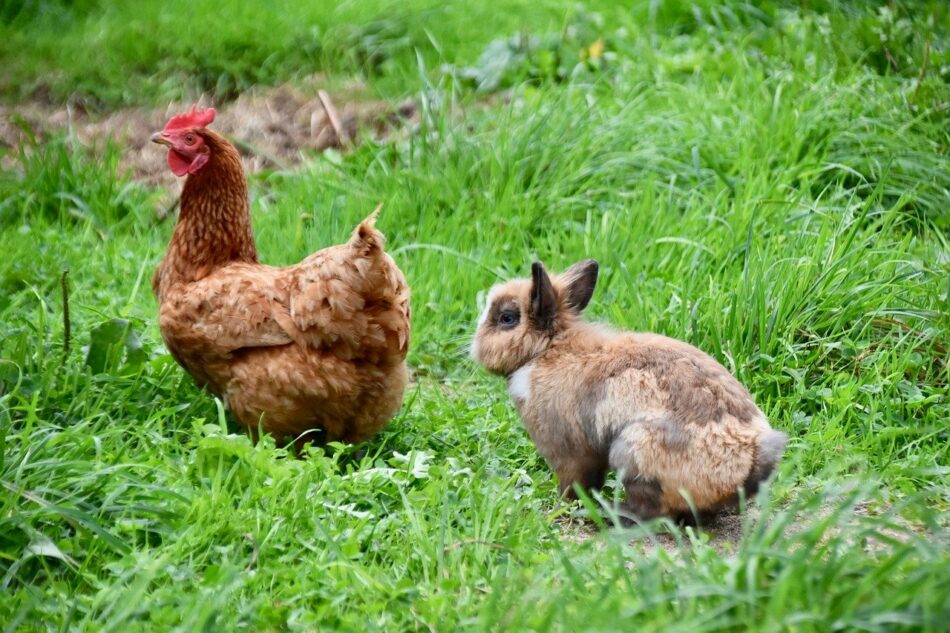
Chickens and other pets
Chickens can also mix happily with goats, and with female ducks (males will tends to bully them). Ironically, they do not mix with birds in an aviary. They will eat anything that falls to the aviary floor, but they will also happily peck the other birds whenever they can and may attract rats and mice, which will cause problems for the smaller birds.
If you live in a rural setting, you can keep chickens with other barnyard animals. Chickens mix happily with:
- Goats
- Sheep
- Cows
- Alpacas or llamas
- Pigs
- Female ducks, guinea fowl, peacocks, geese, or pheasants
Any other avian species kept with chickens should be docile and preferably female, as males can bully hens. Smaller birds like quail or pigeons will likely get pecked at by chickens, so it’s best to stick with larger birds as run-mates. Small pets like hamsters, gerbils, turtles, or frogs should never be kept with chickens – they will be pecked at and killed.
Omlet and your pets
Omlet has all of the pet products you need to keep your furry and feathered family members healthy and happy. Having multiple types of pets is exciting, and through our line of chicken coops, chicken runs, and walk in run partitions, you’ll be able to create a safe haven for all of your animals to enjoy. And, by knowing that Omlet products are protecting your flock, you can rest easy knowing that you’ve provided them with the best chicken housing solutions available.
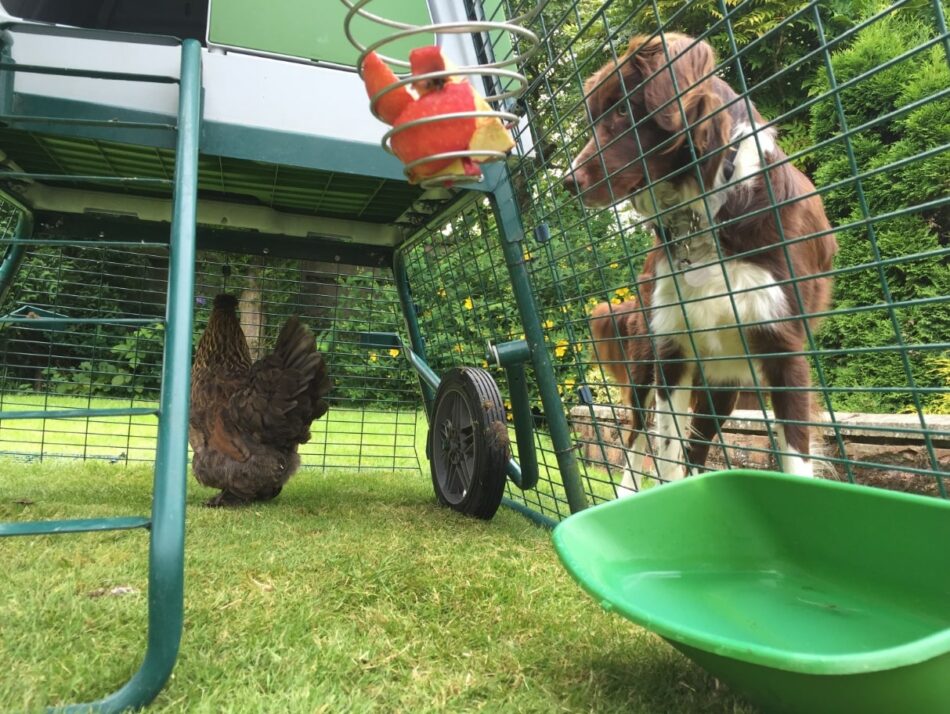
This entry was posted in Budgies on April 14th, 2021 by alisa.deluca

This article is a part of our Pride of Omlet series, a collection of amazing stories which shine the spotlight on extraordinary pets and share their selflessness, bravery, talent and compassion with the world.
-Written by Anneliese Paul
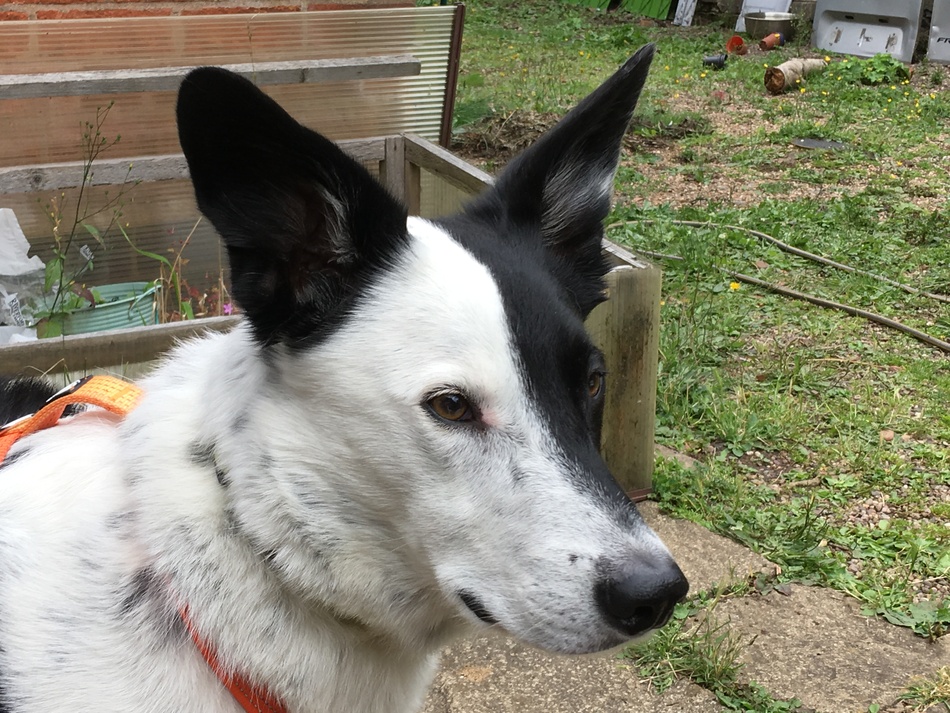
On paper, Kipper wasn’t exactly what Angela wanted. After years of behavioural challenges, he’s become the best-behaved blood donor and saved over forty dog’s lives. Kipper’s turned out to be Angela’s perfect match.
When Angela’s house was burgled, the first thing the police said was, “Get a dog.” Because a dog barks, and people are less likely to enter your home uninvited. But working as a teacher, Angela felt she couldn’t look after a dog, especially not an active breed like a collie.
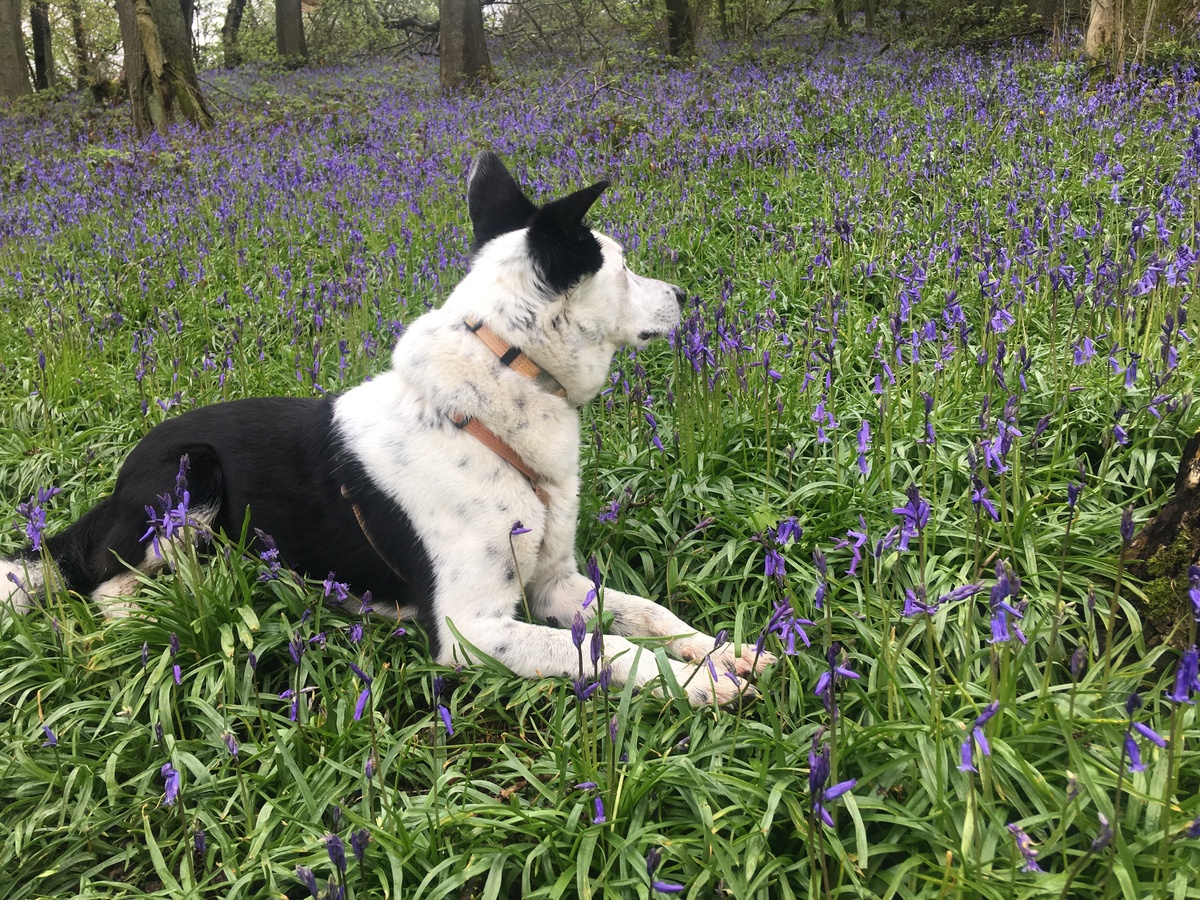
With fond memories of the collie she grew up with, she spent a long time talking to the Border Collie Trust, and they helped her find Kipper. He was an eighteen-month-old Irish stray and had been rehoused multiple times. Being a collie, Kipper had a lot of energy. On paper, he didn’t look right for Angela.
But the Border Collie Trust thought he was the perfect match and persuaded her to meet him. So, she went to the rescue centre to get to know him. Angela could tell he was fantastic with humans, which was really important. So she took him for a walk and fell in love with him. A few weeks later, she brought him home to start their new adventure.
Angela had prepared a lovely kennel and run in the garden for Kipper to spend half the day in. The plan was at lunchtime; he would be walked by a professional dog walker and then left in the house in the afternoon until she got home from school.
Kipper turned out to be hard work, boisterous and disruptive. He destroyed the house and was what Angela describes as ‘over the top’. In the evening, after a long day at work, Angela would go to tie up her shoes for a walk, and he would bite her hair, not in an aggressive way, just incredibly overexcited. It used to take them twenty minutes just to get to the front gate. It was exhausting.
But Angela had experience with Border Collies, she knew he had incredible intelligence, and he just needed things to do. Her teaching instincts kicked in, and with support from the Border Collie Trust, she began what would turn out to be life-changing behaviour training for both her and Kipper.
At first, it was simply stopping and waiting for him to calm down whenever he did something that was ‘over the top’. Then Angela needed to tackle the chewing at home. She started by leaving him for five minutes, going to the front gate, standing across the road, then coming back in and praising him for being good. Angela worked out Kipper’s motivations (toys and food) so that she could effectively train him.
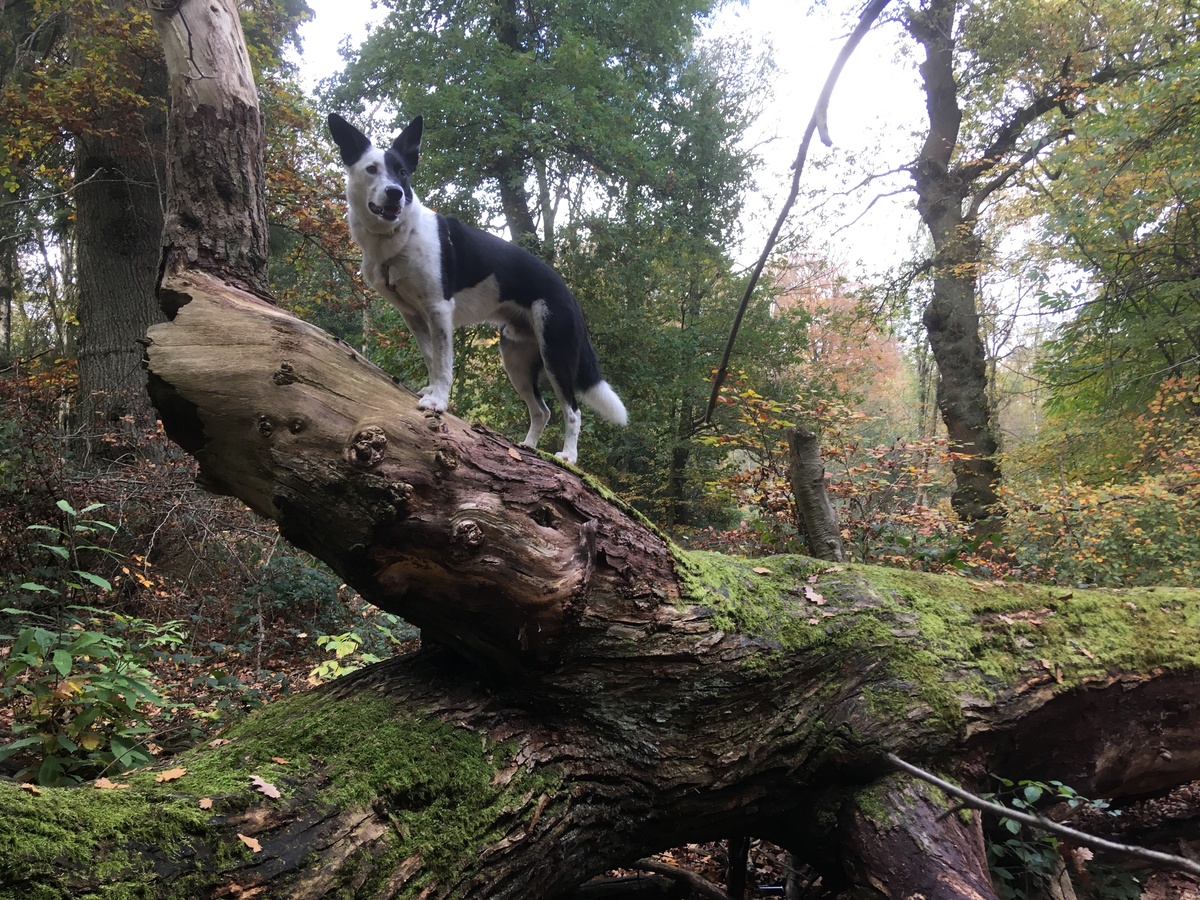
“He is so clever,” says Angela “, That he will work out. What am I being asked to do? What is the reward on offer, and is it worth it? And if it isn’t worth it, he won’t do it.”
Over time he made progress, and his behaviour slowly improved. Angela worked hard with him, and as his obedience improved, their bond grew, so did the trust between them.
Kipper lives on the edge of the countryside and occasionally chases livestock, so he has to wear a muzzle on long walks. But incredibly, Angela can leave him alone, unmuzzled with the chickens in her garden. His behaviour at home has transformed so dramatically that Angela is confident Kipper will do whatever she asks him to. Angela has even watched a big bolshy chicken trying to steal Kipper’s bone!
“The chicken was getting closer and closer and closer, trying to peck at his bone. All Kipper did was pick up the bone and walk away.”
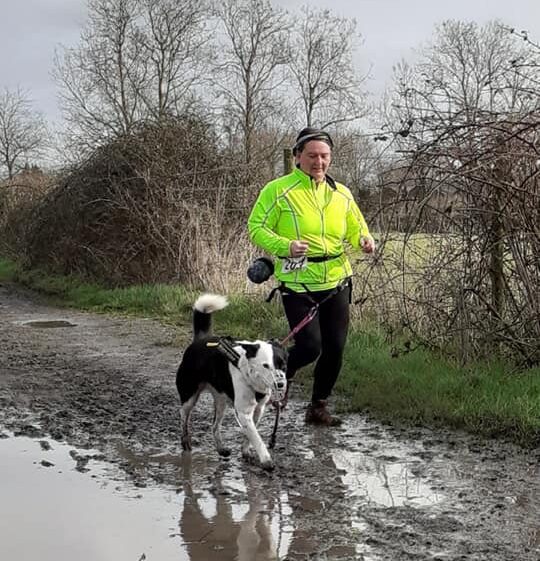
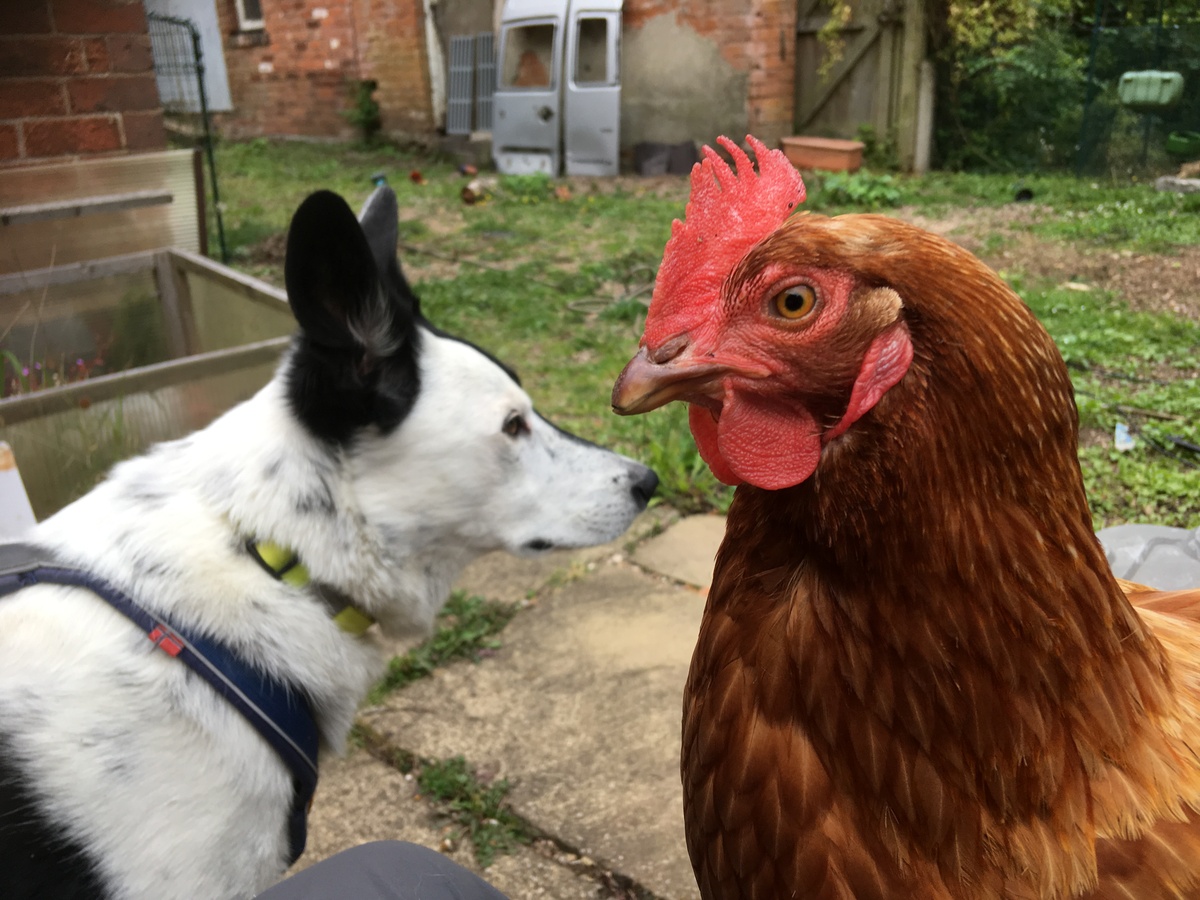
With good obedience at home, they started to have fun together. Kipper achieved Gold in the Kennel Club Good Citizen Dog Scheme and got to the Kennel Club Starters Cup Final in 2017, an agility competition for beginners. The activity and the mental work was fantastic for him, and they both made new friends, travelled to new places and shared memorable experiences.
But when Kipper had to have his dew claws removed, he couldn’t do his agility work, and the lack of exercise led to frustration. Angela, always on the lookout for ways to develop Kipper’s potential, discovered CaniCross. Cani sports are a whole range of sports to nurture the bond between dogs and their owners and are particularly beneficial for dogs with behavioural issues.
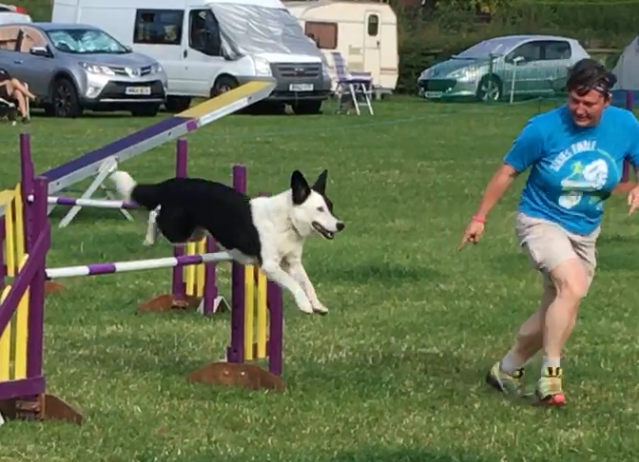
Taking part in cross country runs and triathlons, Angela and Kipper were getting fit together and making strong friendships with a whole community of like-minded dog lovers.
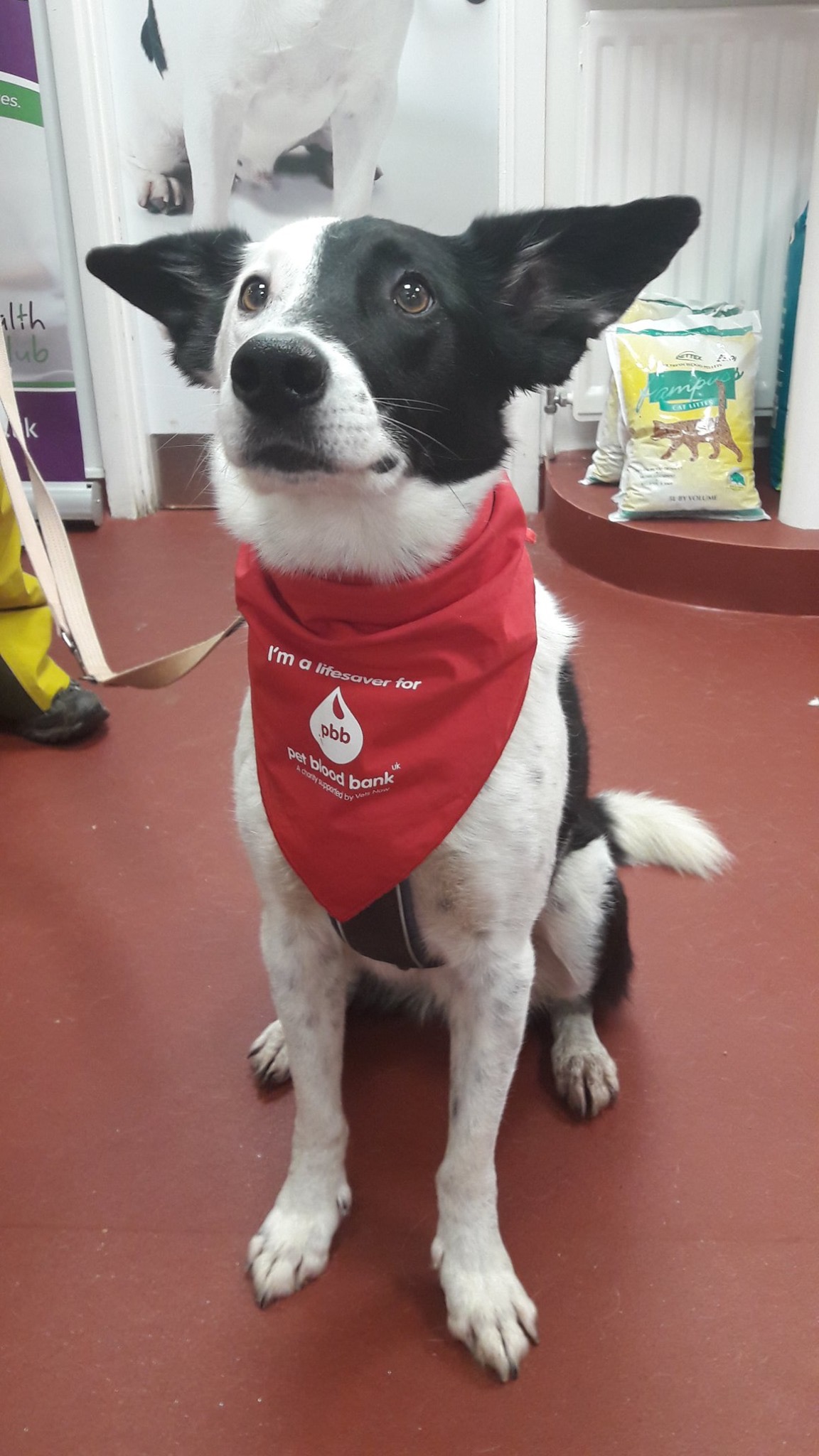
One of their friends introduced them to the pet blood bank. Angela was keen to give back to the dog community, but he was under the 25kg minimum weight. However, as he matured, his muscle development changed. As soon as he’d gained enough weight, Angela registered Kipper as a donor and proudly took him along to his first session.
But Kipper was terrified. He had to have a little piece of fur shaved and couldn’t stand the sound of the clippers. Once again, Angela turned to training. The blood bank advised using an electric toothbrush to get him used to the vibrating sound. Over time, using his favourite soft cheese as a treat to reward good behaviour, Angela gently got him used to sound until she was sure he knew it wasn’t going to harm him.
Finally, Kipper was ready to give blood, perfectly behaved. He’s now on his tenth donation, and with a rare negative blood type, his blood is a perfect match for any dog. With every donation providing blood for up to four other dogs survival, Kipper has helped save forty dog’s lives.
Kipper and Angela have experienced so much together. Pushing each other to do better, they’re a winning team. Motivating each other to get on with life and do something good, to make friends together. As Angela says,
“Not every dog would suit me, and not every owner would suit him, but the Border Collie Trust got it right. We were meant to be.”

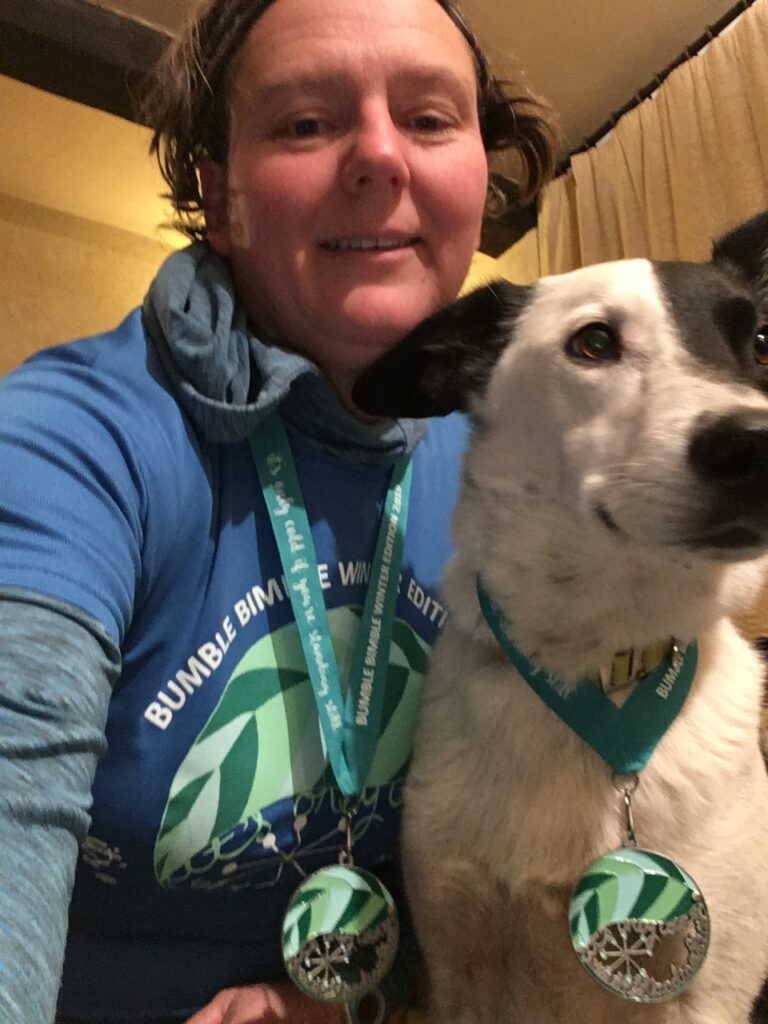
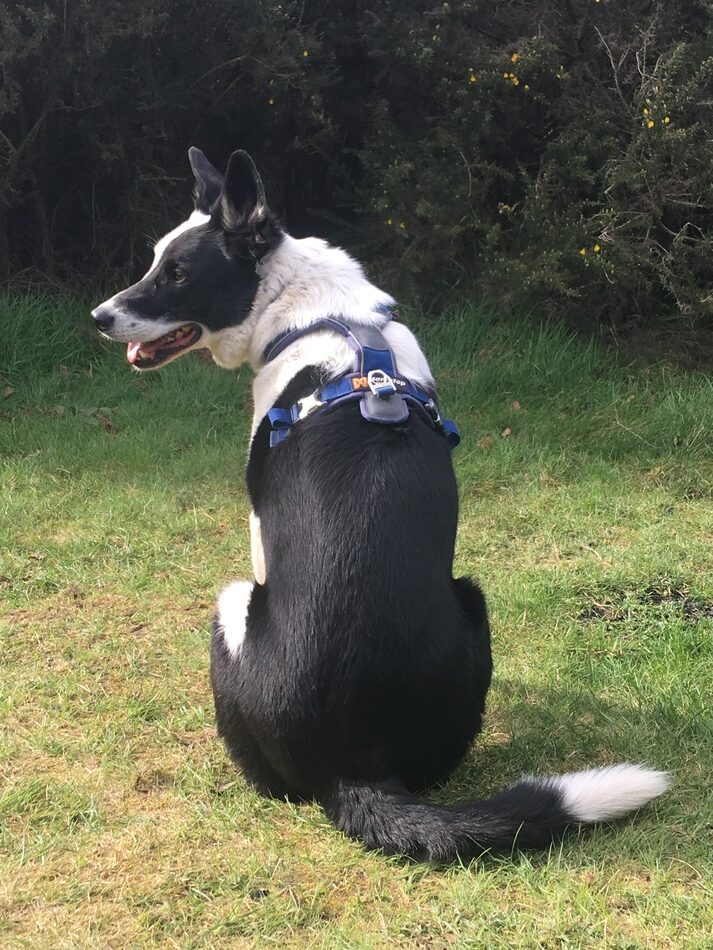
This entry was posted in Dogs on April 13th, 2021 by alisa.deluca

This article is a part of our Pride of Omlet series, a collection of amazing stories which shine the spotlight on extraordinary pets and share their selflessness, bravery, talent and compassion with the world.
-Written by Anneliese Paul
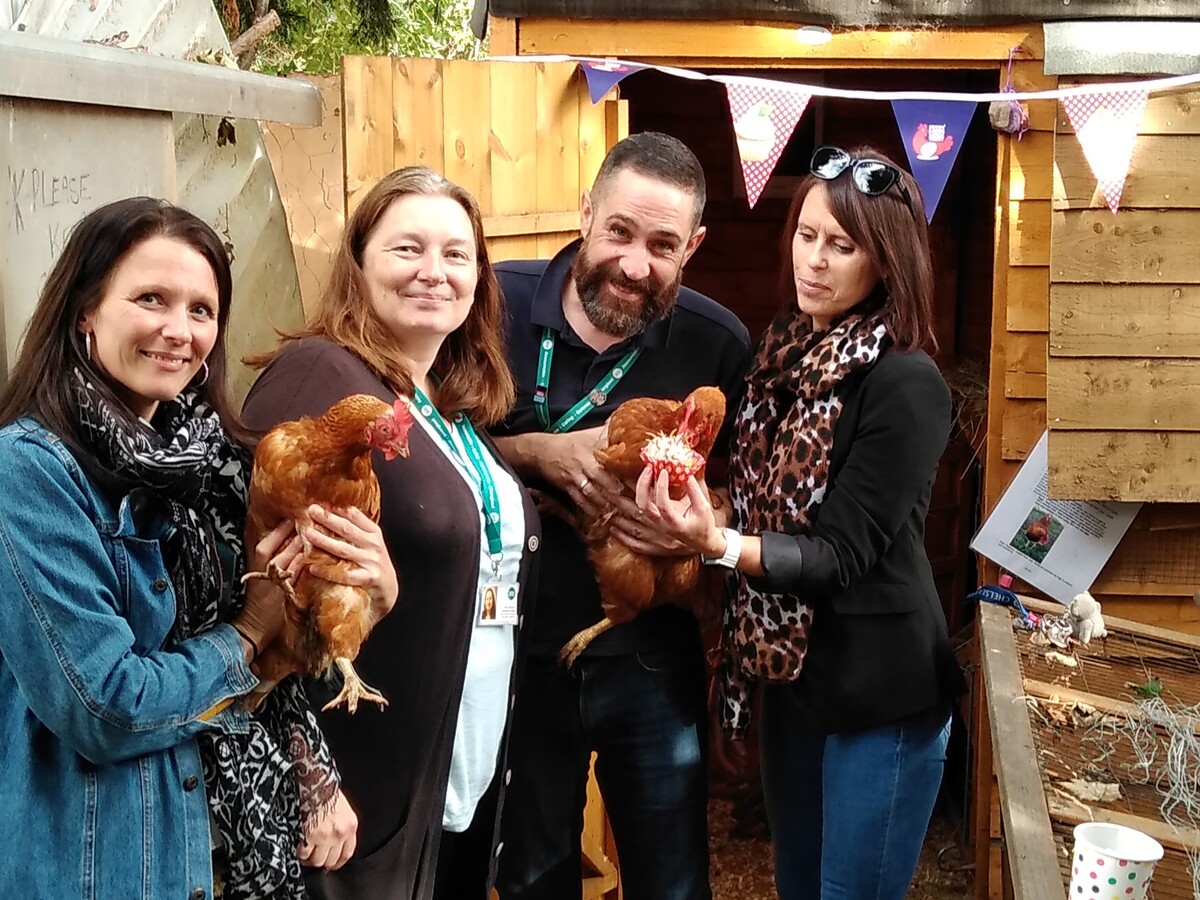
Once caged battery hens, Hennifer Marge and Sybil now work free-range with their human Jonathan, transforming lives for offenders at the Rosemead Project. Jonathan (support worker and chicken champion) believes the hens have the power to unscramble tricky social situations.
The Rosemead Project is a residential home in Southend on Sea that exists to get people in need of support on the right path, by learning independent living skills to transform their lives. Six years ago, Southend council granted the project funding to transform the garden. They installed a polytunnel, created raised beds and planted fruit trees.
Jonathan introduced chickens to the garden. The ex-battery hens arrived in a sorry state, malnourished with large patches of missing feathers and pale, floppy combs. But within a few weeks of scratching in the garden and the compost heaps, they were on the road to recovery.
When residents arrive, often from homelessness or prison, they are welcomed into their bedroom, and a bowl containing two eggs sits on the side table with a note that says ‘Welcome from Hennifer, Marge and Sybil’.
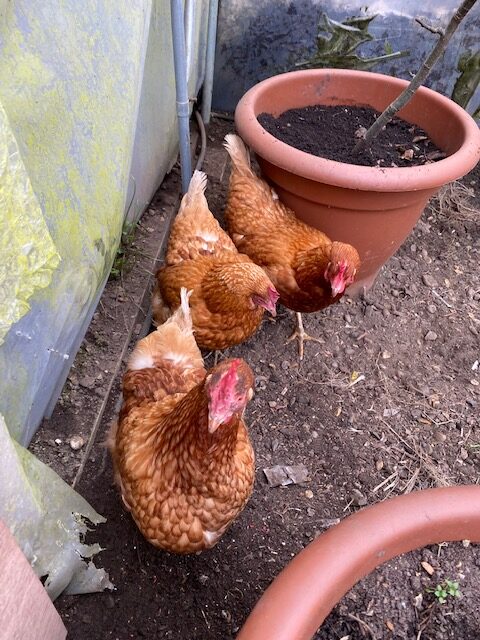
Jonathan uses eggs to teach residents how to cook simple meals, like omelettes. He’s put posters up in the communal kitchen with recipes showing different ways of cooking eggs. The eggs have also become currency, cracking once tricky relationships with neighbors. After an anti-social behavior incident, Jonathan visited Jean, one of the elderly neighbors who was nervous about the project. He took eggs and found that they were a good conversation starter.
It was all going well when a fox came. Doris, the mother hen of their original flock, ran towards the fox to protect the rest of them and was left dead. She’s buried in the garden and a lot of the residents were affected by the attack. So on his next egg delivery to Jean, Jonathan told her about the fox and said he would get some more chickens from the British Hen Welfare Trust. Jean came with him and got some hens too. It was a positive moment.
Hennifer, Marge and Sybil arrived, freed from their horrific caged lives. They’ve been with the project for two and a half years now and are the best-feathered support workers Jonathans ever met. Hennifer is confident, Sybil inquisitive, and Marge is really chilled. She can often be found under the lavender bush.
Residents typically stay with the project for two years before going on to independent living, but the path isn’t always smooth, and occasionally, they are sent back to prison. When this happened to one resident, he contacted the Rosemead Project (through his family) to ask if they could send photos of the chickens, they become an important support to many people living at Rosemead.
Another resident says he loves the sound of chickens clucking when he wakes up. It takes him back to a happy place. And another has taken charge and gets up at 7am every morning to let the hens out. Either sitting or working in the garden, the hens build resident’s confidence. “The hens don’t run away from them. That’s important,” says Jonathan.
Some residents like to buy treats for the chickens, which may seem like a small thing, but when it’s a choice between lager or mealworms and they’re choosing mealworms. It’s a good sign. There’s a trail of jobs that come from the hens that’s good for building life skills and the cleaning and care that goes into looking after a pet provides a sense of responsibility.
Jonathan says, “Sometimes, it’s hard to find positives in this job, but it’s a good thing to give something a quality of life, and the chickens are one of the little things that put a big smile on your face.”



This entry was posted in Chickens on April 6th, 2021 by alisa.deluca





 Mipit’s a Jug like Lottie, who Henley chose for his rebellious nature, but despite wayward first appearances, he’s proven to be intelligent, loving and loyal. Within a few weeks, Mipit was doing things that Lottie had taken months to learn, and Henley decided to focus her assistance dog training with Mipit.
Mipit’s a Jug like Lottie, who Henley chose for his rebellious nature, but despite wayward first appearances, he’s proven to be intelligent, loving and loyal. Within a few weeks, Mipit was doing things that Lottie had taken months to learn, and Henley decided to focus her assistance dog training with Mipit.








 It can be tricky to decide whether or not your dog should wear a collar or a harness for walks. A lot of it depends on your dog himself, from the breed to his age and activity level. No matter what type of breed you have, one thing’s for sure, they all need to go out on walks! The main two types of leash attachments that you can use for your dog are harnesses or collars.
It can be tricky to decide whether or not your dog should wear a collar or a harness for walks. A lot of it depends on your dog himself, from the breed to his age and activity level. No matter what type of breed you have, one thing’s for sure, they all need to go out on walks! The main two types of leash attachments that you can use for your dog are harnesses or collars. 



































